Janice Horton's Blog, page 14
October 16, 2021
Travel Planning: A Step By Step Guide
Can I assume that (like me) you are wanderlusting about when you can travel freely again?
Ever since early March 2020 when the Backpacking Husband and I landed back in the UK for a brief visit with family and friends after housesitting in France – all packed and ready to set off travelling around the world again (well, you know what happened then!) – we’ve been patiently waiting for the day to arrive when we can start travelling extensively again.
I’m being totally optimistic and I’m assuming that in 2022 we will once again have the freedom to travel.
And so – with great excitement – we have just booked flights and we are planning a six-month-long trip!
If you could plan six months abroad – where would you go?
Our plan is to travel to The Caribbean and live a laid-back tropical island lifestyle for six months in 2022 which is exactly what we’d had previously planned for ourselves in 2020! Click on the image banner below to find out more about our Secret Place In The Caribbean and read on to find my Travel Planning Step by Step Guide and Checklist!
 Our plan is to travel to The Caribbean and live a laid-back tropical island lifestyle for six months in 2022I’M HERE TO HELP & INSPIRE YOU TO TRAVEL MORE!
Our plan is to travel to The Caribbean and live a laid-back tropical island lifestyle for six months in 2022I’M HERE TO HELP & INSPIRE YOU TO TRAVEL MORE!My aim throughout this travel website and through my inspirational romantic adventure novels and through my social media and my travel podcasts is to ENCOURAGE and INSPIRE everyone to travel more, once it’s safe to do so, but especially those of you like the Backpacking Husband and I who are in our midlife and want to incorporate more travel into our lives and our future in what I belive to be the Golden Age of Travel!
And so, as you are here and reading this website, I thought that you might be interested in seeing how we go about planning for a longer slower travel experience. I thought it might be helpful to you to know exactly what is on travel planning step-by-step checklist for an extended trip of 6 months or more.
I see it’s actually being reported in the news right now that many people – and especially those of us in our midlife – are looking at Travel in the New Future as some kind of pandemic payback. The media is even calling it ‘revenge travel’ because lockdown has brought about a mind-shift in many of us who are now worried about something else getting in the way of our long-held dreams and plans for travel and adventure in our midlife and in our retirement.
To be honest, I never needed a pandemic to make me feel urgently or longingly about travel.
Until the pandemic, the Backpacking Husband and I had been happily travelling the world for almost seven years and we didn’t ever want our nomadic life of freedom and travel adventure to stop – having sold our home, our business, our cars and all our material possessions – to facilitate travel in our lives and to travel all around the world.
But of course, you might not need to go to the same extremes – although we know many others who have done so – because you might just be looking to take several months taking that ‘once in a lifetime‘ trip to see the places you’ve always dreamed of seeing and to live the amazing experiences that you’ve had on your bucket list or travel wish list for what seems like forever.
Perhaps you’re in your 40s and the pandemic has made you think about working nomadically?
Or you’re in your 50s and 60s and you feel inspired to travel but you’re not quite ready to fully retire yet.
Maybe you’re thinking of taking a work sabbatical to learn something new or to volunteer on a project abroad that feels important to you?
Or are you like my husband who took early retirement or myself who, as a travel writer and author, can work anywhere in the world as long as I have occasional access to the internet?
Or, are you in your late 60s and 70s and feel you’ve reached a stage in life where you don’t want to keep your dreams of travel on hold any longer, because the sands of time are slipping through the hourglass. And you might be reasonably physically fit right now, but any sensible and realistic person knows that as we age, our continued physical fitness cannot be guaranteed.
 Click on the image banner above to read my 10 Reasons To Travel In Your 50s and 60sDO YOU WANT TO TRAVEL MORE BUT FEEL OVERWHELMED OR LIKE SOMETHING IS HOLDING YOU BACK?
Click on the image banner above to read my 10 Reasons To Travel In Your 50s and 60sDO YOU WANT TO TRAVEL MORE BUT FEEL OVERWHELMED OR LIKE SOMETHING IS HOLDING YOU BACK?To get into a travel mindset you must face your fears and ask yourself what is holding you back?
Is it a real tangible fear or an imagined worry? Let’s look at how these might be overcome.
Do you think you’re too old to go travelling? National Geographic says: Life Begins at 50. “Empty-nesters are inspired by their children’s gap years. Young-at-heart empty nesters are increasingly looking to travel. What’s more, they’re heading further afield and for longer, preferring exotica and adventure over slippers and comfort zones.” And goes on to say. “A lot has changed within a generation, and the empty nesters don’t see why they should miss out on what didn’t exist when they were younger.”
Do you think you need to be in better shape? Then make an effort! Try gentle yoga and brisk walks. I make sure I walk/do enough steps every day to maintain a basic level of fitness and to keep my weight within healthy parameters. Wear a ‘fitbit’.
Do you fear flying? Perhaps it’s an issue of age since the fear of flying apparently often starts at 27 years old on average. You can find practical advice and more information on this common anxiety on anxities.com.
Are you afraid of travelling alone? A recent survey also revealed that most over 55’s want to travel as a couple or with a friend or to travel with a group but a solid 10% of them prefer to go it alone to complete their bucket list. And besides, solo travellers are rarely alone as they meet people but, if you are still not sure, have you looked into group tours for solo travellers? There’s lots of great advice and encouragement and tips on travelling solo on solotravelerworld.com.
Do you worry about not having enough money to travel? Look at your resources and research your costs then draw up a budget. I work out travel costs (airlines, busses, trains etc) and accommodation costs as my fixed expenses while travelling and these are the costs I put aside. But food and extras – well we have to eat wherever we are – and so I try to keep day to day living costs the same as at home. When I’ve had to keep accommodations costs down I’ve opted for housesitting and stayed somewhere for free in exchange for looking after someone’s home/pets while they’re away.
Are you scared of being hurt/sick/attacked/unsafe/in danger while travelling? It doesn’t help reading or watching the news as its only ever bad news and that, in my opinion, makes danger seem disproportional. I belive the answer is to be prepared. I wrote a post on dangerous travel situations and how to avoid them and I do highly recommend you read it or listen to it as a podcast (Episode 15) as I think you’ll find it reassuring!
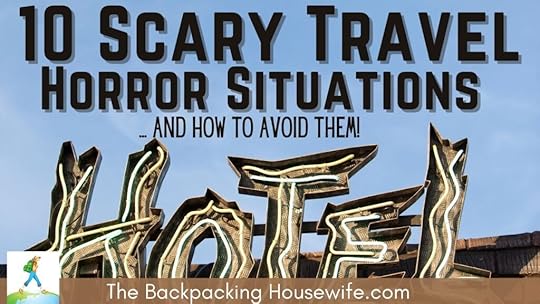 Click on the image banner above to read My 10 Scary Travel Horror Situations and How To Avoid Them!I want to inspire and encourage you to be Bold Not Old and to grab a life of travel while you can!Let’s plan an extended trip of six months of travel to far-flung places!Travel Planning: A Step By Step Guide.
Click on the image banner above to read My 10 Scary Travel Horror Situations and How To Avoid Them!I want to inspire and encourage you to be Bold Not Old and to grab a life of travel while you can!Let’s plan an extended trip of six months of travel to far-flung places!Travel Planning: A Step By Step Guide.Planning for a six-month trip does take some planning because it’s not just about what you choose to take in your backpack or suitcase but rather how prepared you are to travel for an extended period of time. It’s going to be far easier to pre-empt problems before you leave than to have to deal with something that might spoil or suspend your travel enjoyment for the sake of a little foresight.
Please note that our planning list is likely to be far less comprehensive than yours simply because we don’t have a home or a property or a car or any costs associated with a home. This is because, as I mentioned above, we have previously sold everything we owned to travel the world and facilitate our travel adventures.
During the pandemic we have been living in a furnished rented house in Scotland but we have deliberately not bought anything we didn’t really need. We needed some warm clothes and shoes but these were mostly sourced as pre-loved items from charity shops or from eBay. We have also managed without owning a car during this time as, six months into the pandemic, we were eligible to apply for senior concessional bus passes. We sometimes also travel by train.
However, as a homeowner, you will need to automate your bills and re-direct your mail and decide what to do with your property and even perhaps your beloved pets while you are away travelling. You might choose to close up your home for those six months or ask a friend to live in or a neighbour to watch it for you. You could get house sitters in or you might rent it out to help with mortgage or utility payments or add to your travel budget. We once house-sat at a small farm in the South of France for six months while the owners were travelling. It it was a great experience and fabulous fun!
If, like us you currently live in a rented home, then maybe you might see this as the flexibility to rent somewhere else?
 MY STEP-BY-STEP GUIDE ON PLANNING FOR LONG TERM TRAVELTHE SIX-MONTH PRE-TRAVEL CHECKLIST
MY STEP-BY-STEP GUIDE ON PLANNING FOR LONG TERM TRAVELTHE SIX-MONTH PRE-TRAVEL CHECKLIST Decide on the country/countries you want to travel to and check their specific entry requirements.Decide on the dates you’d like to travel and make a travel itinerary.Find out how long you are legally allowed to stay in the country/countries on your itinerary.Check you have a valid passport. Check if you need to pre-apply for a travel visa?Find out what travel vaccines are recommended for travel to the countries in your itinerary.Acquire/apply for credit/debit/travel cards that allow you to access your cash abroad without excessive fees and charges as this will help you to save a considerable amount of your travel budget.Notify your bank of when you’ll be travelling (dates) and which countries you’ll be travelling to so they don’t suspect suspicious use and block your cards while you are away.Check the currency used in the country/countries you want to travel to and if you carry currency with you do make sure the notes are clean and undamaged and not in too high a denomination.Sign up for loyalty/reward membership with the airlines you are using/might use to collect points/air miles.Sign up for loyalty/reward membership with hotel groups you will/might stay with while you are travelling.Get online accounts with Booking.com and other accommodation websites to get deals and build your status (to get discounted deals) on these sites and to make it easy to book your accommodations while on the move.Sign up and buy a Global Entry Pass – which includes TSA approval – to avoid standing in long lines at airport immigration.Book your flights: Book online. I like to use Skyscanner and my recommendation is to always book directly with the airlines. Deals and discounts are often available for travel outside holiday times.Buy comprehensive travel insurance to cover you for your entire trip.If possible book your accommodations for while you are away. Do you want a hotel? A motel? A hostel? A homestay? Live Like A Local or live it up in an all-inclusive resort?What time are your flights? If they are early or late then maybe you need to book airport hotels?Make sure, if you have regular prescription medications, that you have enough for your trip.A FEW EXTRA TRAVEL TIPS AND CONSIDERATIONS FOR PRE-TRAVEL:Decide/buy a suitcase or a backpack. I must admit I favour a wheeled backpack these days.Decide/buy your cabin luggage and make sure it is no larger than the smallest size airlines allow.I back up all my documents and contact information that I keep on my laptop computer and phone – copies of all my travel documents – and all my treasured family and travel photos onto a virtual storage cloud (I pay a small fee monthly for extra space) that I can access via the internet from anywhere in the world. I bought a smaller size and lighter laptop especially for travel and I signed up for a VPN to keep my data secure and I’m currently using Tunnel Bear (not an affilated link).Check your mobile phone is unlocked and takes dual-sim so you can buy local phone/internet access.I travel with a few back up solar power rechargeable itemsPower Assessories" target="_blank" rel="noreferrer noopener"> such as a phone charger and a torch.Forget paperbacks and hardback books and take a Kindle e-readerereader" target="_blank" rel="noreferrer noopener"> loaded with ebooks to read. You might want to read all my bestselling romantic adventure novels while you travel or while relaxing at your destination. You’ll find all my books widely available worldwide in paperpack and as ebooks and from Amazon UK and Amazon Dotcom.
Decide on the country/countries you want to travel to and check their specific entry requirements.Decide on the dates you’d like to travel and make a travel itinerary.Find out how long you are legally allowed to stay in the country/countries on your itinerary.Check you have a valid passport. Check if you need to pre-apply for a travel visa?Find out what travel vaccines are recommended for travel to the countries in your itinerary.Acquire/apply for credit/debit/travel cards that allow you to access your cash abroad without excessive fees and charges as this will help you to save a considerable amount of your travel budget.Notify your bank of when you’ll be travelling (dates) and which countries you’ll be travelling to so they don’t suspect suspicious use and block your cards while you are away.Check the currency used in the country/countries you want to travel to and if you carry currency with you do make sure the notes are clean and undamaged and not in too high a denomination.Sign up for loyalty/reward membership with the airlines you are using/might use to collect points/air miles.Sign up for loyalty/reward membership with hotel groups you will/might stay with while you are travelling.Get online accounts with Booking.com and other accommodation websites to get deals and build your status (to get discounted deals) on these sites and to make it easy to book your accommodations while on the move.Sign up and buy a Global Entry Pass – which includes TSA approval – to avoid standing in long lines at airport immigration.Book your flights: Book online. I like to use Skyscanner and my recommendation is to always book directly with the airlines. Deals and discounts are often available for travel outside holiday times.Buy comprehensive travel insurance to cover you for your entire trip.If possible book your accommodations for while you are away. Do you want a hotel? A motel? A hostel? A homestay? Live Like A Local or live it up in an all-inclusive resort?What time are your flights? If they are early or late then maybe you need to book airport hotels?Make sure, if you have regular prescription medications, that you have enough for your trip.A FEW EXTRA TRAVEL TIPS AND CONSIDERATIONS FOR PRE-TRAVEL:Decide/buy a suitcase or a backpack. I must admit I favour a wheeled backpack these days.Decide/buy your cabin luggage and make sure it is no larger than the smallest size airlines allow.I back up all my documents and contact information that I keep on my laptop computer and phone – copies of all my travel documents – and all my treasured family and travel photos onto a virtual storage cloud (I pay a small fee monthly for extra space) that I can access via the internet from anywhere in the world. I bought a smaller size and lighter laptop especially for travel and I signed up for a VPN to keep my data secure and I’m currently using Tunnel Bear (not an affilated link).Check your mobile phone is unlocked and takes dual-sim so you can buy local phone/internet access.I travel with a few back up solar power rechargeable itemsPower Assessories" target="_blank" rel="noreferrer noopener"> such as a phone charger and a torch.Forget paperbacks and hardback books and take a Kindle e-readerereader" target="_blank" rel="noreferrer noopener"> loaded with ebooks to read. You might want to read all my bestselling romantic adventure novels while you travel or while relaxing at your destination. You’ll find all my books widely available worldwide in paperpack and as ebooks and from Amazon UK and Amazon Dotcom.
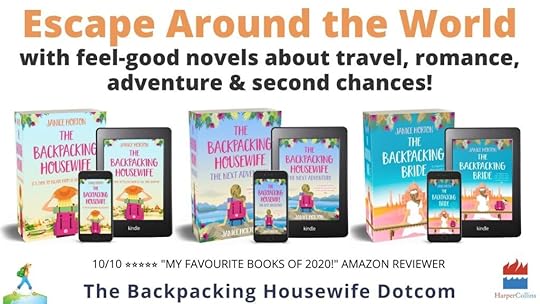 WHAT TO PACK IN YOUR SUITCASE OR BACKPACK.I recommend you travel light whenever possible. As a rule, only take enough clothes for one week – you can wash them – or you might buy more suitable/affordable clothes when you’re at your destination.Keep the things you value the most in your hand luggage rather than your checked luggage.Travel compression bags or packing cubes might help to keep your things tidy in your luggage.Travel with an easy-dry travel/beach towel to save weight and space in your luggage.A worldwide travel power adapter and a small first aid kit is essential kit.I always travel with one warm sweater and a warm shawl/pashmina in my cabin bag plus one change of clothing including underwear and a swimsuit/bikini – just in case of a luggage loss/ delay.I travel with very few toiletries because you can usually buy them at your destination (this is especially true with insect repellents) BUT I would never want to be without a tub of coconut oil.
WHAT TO PACK IN YOUR SUITCASE OR BACKPACK.I recommend you travel light whenever possible. As a rule, only take enough clothes for one week – you can wash them – or you might buy more suitable/affordable clothes when you’re at your destination.Keep the things you value the most in your hand luggage rather than your checked luggage.Travel compression bags or packing cubes might help to keep your things tidy in your luggage.Travel with an easy-dry travel/beach towel to save weight and space in your luggage.A worldwide travel power adapter and a small first aid kit is essential kit.I always travel with one warm sweater and a warm shawl/pashmina in my cabin bag plus one change of clothing including underwear and a swimsuit/bikini – just in case of a luggage loss/ delay.I travel with very few toiletries because you can usually buy them at your destination (this is especially true with insect repellents) BUT I would never want to be without a tub of coconut oil.
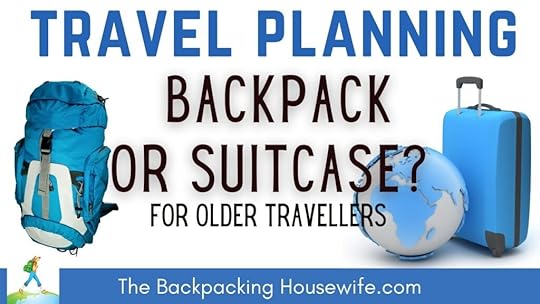 Click the image banner above to read Backpack or Suitcase for older travellersPRE-PLAN YOUR SECURITY WHILE TRAVELLING:ALWAYS travel with travel insurance. Buying a travel insurance policy to cover you for any unforeseen medical expenses or financial losses while travelling is an essential part of the planning and preparation for any trip. Finding the best travel insurance policy when you are travel planning and over 50 years old can be difficult and confusing but travel insurance is something we can’t afford to travel without at any age.It’s handy to have your own small security safe with you if the accommodation doesn’t offer one.I wear a hidden ‘security belt’ or a ‘bra wallet‘ when I travel with secret hidden pockets to keep cards and cash secure.I also travel with TSA Approved luggage locks and a Pacsafe cable lock that I can use to secure my possessions if needed.If you intend to use hostels or homestays or if you travel solo then you might find travelling with extra personal small security items comforting and reassuring: like an Epictraveller door jam or personal alarm.Make sure family or loved ones at home know of your travel plans and itinerary. Stay in regular touch with friends and family while travelling (and show them your amazing travel photos!) via social media and messaging apps. It’s also a good idea to leave loved ones at home a copy of your passport and your travel insurance just in case they or you need to refer to them again.
Click the image banner above to read Backpack or Suitcase for older travellersPRE-PLAN YOUR SECURITY WHILE TRAVELLING:ALWAYS travel with travel insurance. Buying a travel insurance policy to cover you for any unforeseen medical expenses or financial losses while travelling is an essential part of the planning and preparation for any trip. Finding the best travel insurance policy when you are travel planning and over 50 years old can be difficult and confusing but travel insurance is something we can’t afford to travel without at any age.It’s handy to have your own small security safe with you if the accommodation doesn’t offer one.I wear a hidden ‘security belt’ or a ‘bra wallet‘ when I travel with secret hidden pockets to keep cards and cash secure.I also travel with TSA Approved luggage locks and a Pacsafe cable lock that I can use to secure my possessions if needed.If you intend to use hostels or homestays or if you travel solo then you might find travelling with extra personal small security items comforting and reassuring: like an Epictraveller door jam or personal alarm.Make sure family or loved ones at home know of your travel plans and itinerary. Stay in regular touch with friends and family while travelling (and show them your amazing travel photos!) via social media and messaging apps. It’s also a good idea to leave loved ones at home a copy of your passport and your travel insurance just in case they or you need to refer to them again.
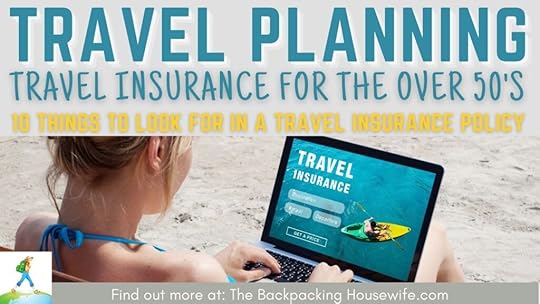 Have a fantastic trip!
Have a fantastic trip!Did you find my travel planning checklist useful?
Where are you planning to travel?
What’s on your Bucket List?
Are you planning the Trip of a Lifetime?
Are you planning long slow travel?
Are you looking to incorporate more travel in your life and your future?
Let me know! I’d love to hear from you.
Leave a comment below or contact me directly through my contact page
Or message via my social media channels. I promise to reply.
The post Travel Planning: A Step By Step Guide appeared first on The Backpacking Housewife.
October 14, 2021
Let’s Escape to Nassau Bahamas!
After several months of backpacking and travelling extensively throughout the Caribbean and Central America and parts of North America, the Backpacking Husband and I decided to take a flight from New Orleans and escape to The Bahamas for a fabulous month-long stay in Nassau.
And, in this post, I want to share with you our fabulous month-long experience and My Top 5 Tips for Nassau Bahamas! I also want to show you exactly how you too can escape to Nassau Bahamas and have a whole lot of fun on a comparatively small vacation budget in a dreamy and relaxing tropical location and throw in some occasionally incredible (and affordable) five-star Bahamian lifestyle experiences in the mix!
Where are The Bahamas?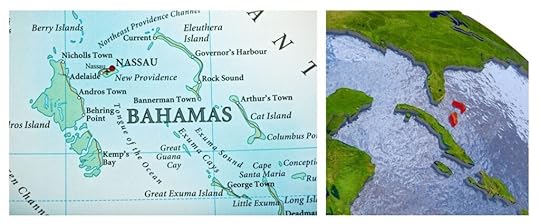 The closest island in the Bahamas is only 45 miles from the coast of Florida
The closest island in the Bahamas is only 45 miles from the coast of FloridaIn the northeastern Caribbean Sea, there’s an archipelago of around 700 beautiful tropical islands, atolls and islets – including around 2,000 small ‘cays’ – surrounded by a coral reef and spread over an area of 500 square miles. Many of these islands are privately owned and about 30 of the islands are inhabited.
With clear azure blue waters filled with exotic marine life, these islands are an idyllic tropical travel destination. They are a haven for those who love fishing, boating, diving, snorkelling, sailing and scuba diving. For beach-lovers there are over 2,000 sun-soaked white sand beaches – although some are pink – and colourful gardens with swaying palm trees and exotic tropical flora and fauna.
The islands I’m describing to you are known as The Bahamas.
Doesn’t this sound to you like the perfect place to kick back and escape for a month or so?
Nassau is the capital city of The Bahamas and is located on an island called New Providence.
Let’s Escape To Nassau Bahamas! The distinctive pastel-coloured buildings of Downtown NassauWhere to stay in The Bahamas?
The distinctive pastel-coloured buildings of Downtown NassauWhere to stay in The Bahamas?Accommodation is plentiful and hotel options are extensive throughout The Bahamas and Nassau and you might want to consider staying across the bridge from Nassau on the smaller neighbouring Paradise Island with the original ocean-themed Atlantis Resort. I recommend you research and book your accommodation online.
We wanted to stay in Nassau for a whole month. So, as with anywhere else in the world where we decide to stay longer than a week or so – with respect to our travel budget – we looked to try and find affordable rental accommodation.
We were incredibly lucky to find a fabulous private home listing on Airbnb offering a private annexe apartment rental. The annexe was part of a gorgeous colonial-style clapperboard house and in a location just across the street from the world-famous Cable Beach.
Cable Beach is a fabulous two-and-a-half-mile long soft sandy beach that is flanked with luxury properties and five-star hotel resorts including, for example, Sandals Royal Bahamian (once the elegant Balmoral Club in the 1940s) with its own offshore private island.
 The world-famous Cable Beach Bahamas
The world-famous Cable Beach BahamasOur accommodation – opposite the very same famous beach and at a fraction of the price of the surrounding accommodations – offered us a double bedroom, a bathroom, a small kitchen and a conservatory-style sitting room.
It was gorgeous and, importantly, it was more affordable than a hotel!
Our Airbnb host kindly offered to meet us at the airport and to drive us back to his home. We spotted him at arrivals holding up a sign with ‘welcome… and our name’ and he was immediately friendly and helpful and introduced himself to us as Stuart – a retired teacher. We also discovered our host was from the UK – Wales – and had lived in Nassau for 25 years.
On route back to his property via the scenic and coastal West Bay Street, we chatted and he pointed out to us all the incredibly expensive homes that we passed along Cable Beach and told us which music star or TV celebrity or famous actor lived in them. He also pointed out the amazingly luxurious 5-star hotels.
Stuart was a generous host and a great guide on the area. He also stopped off at the supermarket to give us the opportunity to go shopping to fill our fridge with food and drinks. We really appreciated this as we intended to mostly cook for ourselves during our stay. We certainly wanted to enjoy all that The Bahamas had to offer but we also wanted to relax and experience living like locals – hence wanting to find an apartment for rent. We also believed that using public transport rather than hiring a car would help to stretch our budget and perhaps allow for a few Bahamian adventures.
Stuart gave us lots of information on places to go and insider tips on how to best get around.
Getting Around Nassau Bahamas.Our host also told us about the colourful local transport known as the Jitney Bus, which would get us from Cable Beach to Nassau town and back again (#10). The Jitney bus is an affordable and popular way (at about $1.50 a ticket and you’ll need cash in Bahamian dollars) to get around Nassau but it’s worth knowing they don’t run after 6.30 pm in the evening. It’s also a really fun way to get around as the iconic minibuses are usually driven by colourful local characters blasting out reggae music and, as the driver’s earnings are dependent on how many fares they take, they are always very accommodating and will often stop to pick you up between stops if you wave them down.
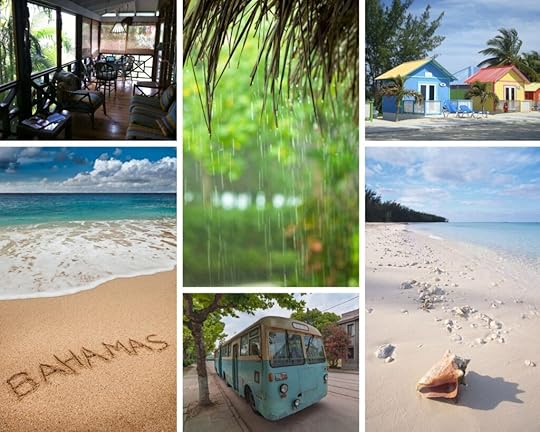 Before and after the rain! We were lucky to find a fabulous private home to rent opposite Cable BeachNassau Bahamas Weather.
Before and after the rain! We were lucky to find a fabulous private home to rent opposite Cable BeachNassau Bahamas Weather.The Bahamas is in the tropics and so has tropical weather patterns. Throughout the year, the temperatures fall between a balmy 25 and 32 degrees Celsius (77-90° Fahrenheit). May to October is the rainy season. The hurricane season lasts from the 1st of June to the 30th of November when there is a higher chance the islands could be hit by tropical storms.
July and August are the hottest months with temperatures around 32° C (90°F). During December, January, and February, the average temperature is around 25 degrees Celsius (77° F).
We were in Nassau during the month of June, and for our first few days, it rained heavily. We didn’t mind staying inside our cosy new home listening to the tropical rain falling, as we desperately needed to catch up on lost sleep and to get some rest before we had the energy for more fun and adventure.
I guess we really needed a month-long vacation from our nomadic backpacking lifestyle!
And, during these first wonderful few days of rest and rejuvenation, I picked up a coffee table book on The Bahamas and discovered that the islands boast a rich and interesting history.
The islands were originally inhabited by Lucayans – a subgroup of Arawak Indians – until Christopher Columbus arrived in October 1492. Then slavery, disease, and other sordid hardships wiped out the entire Lucayan tribe within 25 years. The British arrived in 1647 and the Bahamas officially became a British colony in 1717 and again in 1783. In the late 17th and early 18th centuries, The Bahamas were home to the real Pirates of the Caribbean. The pirates, based at Nassau, (then called Charles Town) attacked French and Spanish ships during a time when piracy flourished because of the island’s proximity to important shipping lanes and trade routes under the leadership of the infamous Edward Teach, better known as Blackbeard. You can get a real idea of what life was like back in those swashbuckling and rum-soaked golden days of pirating at the Pirates of Nassau Museum which offers visitors an interactive pirate experience and features a moonlit replica of Nassau’s harbourfront as it looked in 1716!
What Country Owns The Bahamas?Some people mistakenly assume that The Bahamas belongs to the United States of America – as the closest island in the archipelago is only 45 miles from the coast of Florida – but after 325 years of British rule the Bahamas became an independent country within the Commonwealth of Nations in 1973. July 10th is Bahamian Independence Day.
Exploring Nassau Bahamas.On our 4th day in Nassau the sun came out and so we headed downtown on a Jitney bus. We hopped onto the crowded #10 and rode into town on the distinctive white with a blue strip minibus bus driven by a colourful Rastafarian. Everyone on the bus, including us, sang along to Bob Marley’s ‘One Love’ blasting from the sound system.
We rode past the famous all-day Fish Fry at Arawak Cay – a strip of beachside seafood restaurants and street food stalls offering local foods that are a famous tourist attraction – and made a note to ourselves to go there soon to sample the local cuisine like Johnny cakes and famous Bahamian fish stew and conch salad.
Downtown Nassau is filled with narrow streets around twenty square blocks of centuries-old buildings and magnificent architecture and modern murals by local artists. Those with an appreciation of colonial architecture should visit the Bahamian Parliament Building. Built in 1815 it overlooks a white statue of Queen Victoria in Parliament Square.
A walking tour will include The Queen’s Staircase of 66 steps that were painstakingly carved out of solid limestone rock by 600 slaves between 1793 and 1794 to create an escape route from the fort above and are a major landmark of Nassau. There are restaurants and cafés and museums and luxury shops aplenty. The famous Straw Market is a great place to find authentic locally made hats and handicrafts and trinkets made from seashells. Don’t forget to haggle.
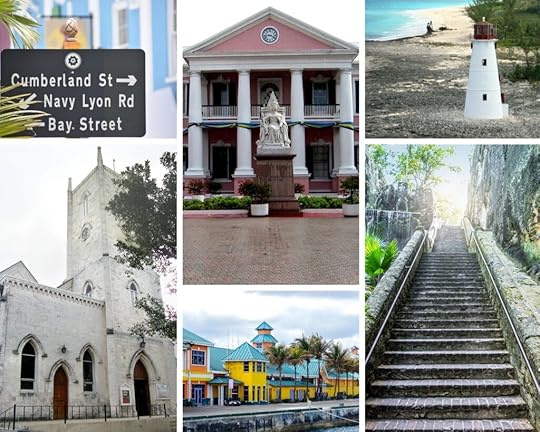 Downtown Nassau has narrow streets and centuries-old buildings and structures. Is Nassau Bahamas Safe?
Downtown Nassau has narrow streets and centuries-old buildings and structures. Is Nassau Bahamas Safe?The Bahamas (particularly the Outer Islands) are a relatively safe place for tourists and there is a strong police presence in touristy areas like Nassau but that doesn’t mean you shouldn’t stay vigilant. On the UK Foreign Travel Advice website it states there have been incidents of violent crime including robbery, which is often armed and sometimes fatal, in residential and tourist areas of New Providence, Grand Bahama and Freeport. I’ve heard that the most serious crime is in the local “Over the Hill” area south of Shirley Street, Nassau, which should be avoided.
The advice is not to walk alone away from the main hotels, tourist areas, beaches and downtown Nassau, particularly after dark. Take care if travelling on local bus services after dusk on routes away from the main tourist areas. Don’t carry large amounts of cash or jewellery. Don’t resist in the event of an attempted robbery.
I actually had a scary experience in Nassau, when we inadvertently found ourselves in a notoriously dangerous part of town at midnight and during a power blackout. It happened after we’d been in the Bahamas for a few weeks, when one evening, my husband and I had travelled into town on a Jitney Bus to meet with a couple of new tourist friends we’d met earlier that day.
We’d arranged to meet for dinner and drinks at the famous Arawak Fish Fry area. We ended up staying out much longer than we’d intended. We were having fun and had found a bar with a nice vibe. When the bar closed, just around midnight, we were the last to leave.
We decided that we’d all share a taxi back up the road so we went out into the street to look for a taxi but found the street empty and quiet. We’d all had quite a few drinks, but I suddenly felt quite sober on realising we might have put ourselves in a precarious situation. We’d been warned that this part of Nassau was a potentially dangerous place for tourists late at night.
And then, suddenly and unexpectedly, we were plunged into complete darkness.
There were no lights on anywhere and we soon realised this was a power cut situation. We just stood there in the dark not knowing what to do. There were no taxis on the street. There was nowhere open. The bar we’d been in was locked up.
We used our phones as torches but realised that we didn’t have any taxi numbers.
Suddenly a big truck appeared out of the darkness and stopped right beside us. I was scared.
The four of us were caught in its headlights and must have looked like frightened rabbits in a spotlight. Luckily for us, the driver wasn’t about to rob us or kidnap or murder us. He simply wanted to offer his assistance. His exact words were “What the heck are you guys doin’ down here?”
He saw we were tourists and he knew we shouldn’t have been there. He told us this wasn’t a good place for us to be so late at night and he offered us a ride back to the area where we were staying.
Seeing that he had lots of pots and pans and cooking paraphernalia in the back of his truck and that he was obviously a street food vendor at the fish fry, we gratefully accepted.
As he dropped us off on the road where we were staying, his passing comment and instruction as we thanked him profusely for his kindness (and offered him some cash for his fuel and inconvenience that he refused to accept) was to suggest to us that if we ever saw him lost and in the wrong place in our country, that we would also stop to help him out.
Lesson learned: Take responsibility for your own safety but also know that not everyone is out to get you. There are good people everywhere in the world, and in my experience, the kindness of strangers is more widespread than you might expect.
You can read about a few more of my scary experiences while travelling (you can listen to this as a podcast Episode 15) and in my post entitled 10 Scary Travel Horror Situations And How To Avoid Them and by clicking on the image below.
 Clicking on this image will open my post on 10 Scary Travel SituationsMY TOP 5 TRAVEL TIPS FOR NASSAU BAHAMAS
Clicking on this image will open my post on 10 Scary Travel SituationsMY TOP 5 TRAVEL TIPS FOR NASSAU BAHAMAS(1) Riding a Jitney Bus and (2) visiting the Fish Fry at Arawak Cay and (3) exploring Downtown Nassau are three travel tips that I’ve already mention to you. BUT did you know that you can buy a VISITOR DAY PASS for entry into many of the fabulous 5-star hotel resorts along Cable Beach like The Royal Bahamian Sandals Resort and also the Atlantis Waterpark on Paradise Island?!
Day Passes: We went into The Royal Bahamian Sandals Resort several times during our stay. We took a Jitney bus along the street and turned up at 9.30 am and in time for a champagne breakfast. Then we enjoyed sunbathing on the luxury loungers and using the fabulous swimming pool, we drank cocktails at the swim-up bar, ate at the restaurants and snack bars and made sure to make the most of all the premium all-inclusive facilities. We even took a boat launch for lunch (with a bottle of excellent wine) on the private island.
As a bonus while at Sandals, we met some lovely people with whom we’ve remained close friends.
Taking a day ticket was an incredible and affordable way to have a five-star premium all-inclusive resort experience that I can recommend to you. Well, until 6 pm, anyway!
I believe there might only be a limited amount of day tickets available per day so do get there early.
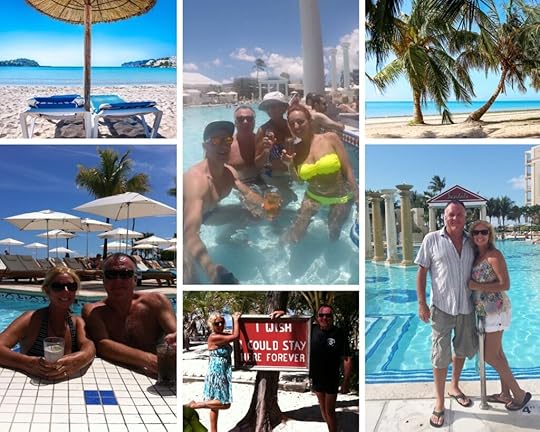 Taking a day ticket was an affordable way to have a five-star all-inclusive resort experience
Taking a day ticket was an affordable way to have a five-star all-inclusive resort experienceExperience Atlantis Resort on Paradise Island. We actually booked a whole weekend stay at Atlantis Resort because not only did we want to spend a whole day in their famous ocean-themed waterpark but we also wanted to see the ‘once in a lifetime live performance of Lady Gaga and Tony Bennett in concert and staying overnight was the only way to get tickets.
We had a truly fantastic time and it was well worth splashing out on the entire weekend! The Atlantis Day Pass allows you to enjoy Aquaventure – a one-of-a-kind water park with thrill slides and refreshing pools and miles of white sandy beaches.
Explore marine habitats and marine exhibits; dine al fresco and choose from a variety of fine dining and casual experiences; try your luck in the Atlantis Casino, stroll our Marina Village and check out the new arrivals at the Crystal Court Shops. Tickets must be purchased in advance.
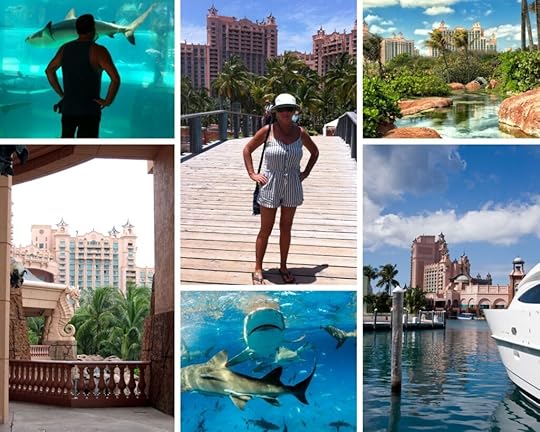 We had a truly fantastic time and it was well worth splashing out on Atlantis Resort!
We had a truly fantastic time and it was well worth splashing out on Atlantis Resort!I hope you’ve enjoyed seeing my photos and reading about my own escape to Nassau Bahamas.
I do hope my tips for having lots of fun and adventure are useful to you.
Perhaps you’ve also been to The Bahamas?
If so, what was your favourite thing to do there?
Or are you still planning an escape to these fabulous islands!
Are The Bahamas on your travel bucket list?
Let me know!
Leave a comment below or message me on my contact page.
I’m on social media too and I’d love to hear from you or answer your travel questions.
The post Let’s Escape to Nassau Bahamas! appeared first on The Backpacking Housewife.
August 20, 2021
San Francisco – A Fabulous Weekend Itinerary!
I want to share with you a truly fantastic two-day trip to San Francisco California and to detail our fabulous mini-itinerary so that if like us, you can only manage a weekend or a two-day break in San Francisco, you’ll waste no time at all in having fun and amazing experiences.
Over two fabulous days, we explored the streets of San Francisco on foot and also using the famous San Francisco cable cars, we ate amazing food in San Francisco restaurants, we hired bicycles and cycled over the Golden Gate Bridge, and of course, we toured and explored the decommissioned prison on Alcatraz Island.
And each of these adventures and iconic experiences were on our travel wish list or bucket list – and we were so excited to be in The Golden City – a popular nickname for San Francisco derived from the gold rush days!
We’d almost made it to San Francisco a couple of times while we’d been in the USA previously – but somehow it just hadn’t happened – this time, we were on our way over from Asia transiting through the USA.
We flew in from Seoul, South Korea, via Beijing China to San Francisco, and we planned to take a two-day pit stop in San Francisco before making our way down to the Caribbean to spend the summer.
Interestingly, during that flight over the Pacific Ocean, we experienced time travel as we crossed the International Date Line and arrived in San Francisco half an hour before we actually left Seoul in South Korea.
How crazy is that?
Of course, in real-time, we had been travelling so long that we were exhausted and jet-lagged. But we didn’t let that stop us. In those days, this was pre-Covid of course, and so we just pushed through with jet lag and didn’t stress about it.
So, wondering what to do in San Francisco in just two days?
 San Francisco – A Fabulous Weekend ItineraryHow to spend two fun action-packed days in San Francisco!Day 1: AM
San Francisco – A Fabulous Weekend ItineraryHow to spend two fun action-packed days in San Francisco!Day 1: AMFirst up… where to stay. We’d booked a room at the Holiday Inn Express in the Fisherman’s Wharf area in downtown San Francisco and, on this occasion, we stayed completely FREE using our points collected on our IHG Loyalty Card.
TOP Travel Tip: Collect those hotel and flight loyalty points for upgrades and free stays/flights as soon as you can. We did so from the outset and we now regularly stay in upgraded rooms and suites with all the perks on just booking a regular room through the IHG Hotels and Resorts App.
We explored the Fisherman’s Wharf area and took a leisurely walk around Pier 39. We watched stormy looking clouds roll in across the bay and we stopped to watch the sea lions that have made the place their home and were sleeping on the wooden dock.
We had a browse in the souvenir stores selling t-shirts and touristy trinkets. We admired the view of Alcatraz Island and enjoyed what was a beautiful but breezy day. I’ve heard that the San Francisco weather can be notoriously foggy and chilly with strong winds at certain times of the year.
We were there mid-April and it was an absolutely perfect time to visit.
There are so many songs about San Francisco and while you are there it’s hard not to bring them to mind and to quietly hum the tune to ‘San Francisco – Be Sure To Wear Flowers In Your Hair’ or ‘Sittin’ On The Dock Of The Bay’ or ‘I Left My Heart In San Francisco’ – or maybe that’s just me!
While we were at Pier 39 on Fisherman’s Wharf – with wonderful views of the bay – we had classic and delicious clam chowder from a sourdough bread bowl at a restaurant called ‘Chowders‘ for lunch!
For those of you who aren’t sure what a clam chowder is: It’s a thick and creamy chicken and potato broth soup with clams – that’s a kind of shellfish – for which San Francisco is famous and there are many restaurants claiming the best clam chowder!
 We explored the Fisherman’s Wharf area and took a leisurely walk around Pier 39. Day 1: PM
We explored the Fisherman’s Wharf area and took a leisurely walk around Pier 39. Day 1: PMAfter lunch and after exploring the pier, we were keen to explore the streets of San Francisco – especially the steep streets – and to travel up and down them on a cable car.
There are three cable car routes to choose from and we chose to take the cable car from Fisherman’s Wharf turnpike all the way to Union Square where it turns around at the junction of Market and Powell Street and then heads back up the street again.
You can ride on the cars by sitting on seats inside or outside. You are also allowed to stand. Lots of people stand whether there are seats available or not – often on the running boards while hanging onto a pole – as this is how you get the best views of the steep streets and the harbour.
The cable car system is fascinating and unique.
Built in 1873, the cable car system is synonymous with the streets of San Francisco and it’s the last working system of its kind in the world. The cable cars are powered by an engine located in a central powerhouse and they move by gripping an underground cable that is in constant motion. The man operating the cable car is called the gripman as he is responsible for operating the grip and also ringing the bell.
We bought our cable car tickets from the ticket booth at the Fisherman’s Wharf turnpike and our tickets cost $8 each way.
As well as riding on the cable cars you can also visit The Cable Car Museum on the corner of Mason Street and Washington Street. It’s free to enter and you can see historic cable cars and displays of interesting old photographs.
And, as this is actually the powerhouse of the cable car system, you can watch the huge engines at work as they pull those colossal cables that run the cars in use on the streets.
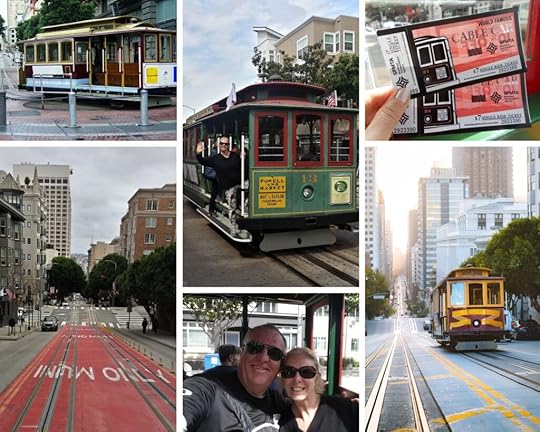 We were keen to explore the streets of San Francisco – especially the steep streets – and to travel up and down them on a cable car. Day 2: AM
We were keen to explore the streets of San Francisco – especially the steep streets – and to travel up and down them on a cable car. Day 2: AMWe were up and about early as we were very keen and excited to rent bikes and cycle over the Golden Gate Bridge in the morning and then our plan was to take the afternoon ferry over to visit Alcatraz Island.
Cycling over the Golden Gate Bridge was always a bucket list thing for me to do once we got to San Francisco and, although that might sound like a super energetic and exhausting and even difficult thing to do – it’s actually not – even if you haven’t been on a bicycle for years.
This is because the cycle ride from Fisherman’s Wharf will take you on a leisurely route through the Aquatic Park, Fort Mason, the Marina, and The Presidio National Park on a mostly flat car-free paved bike path all the way to the base of the bridge.
And, cycling across the bridge itself, is also done on a car-free sidewalk with a barrier there to protect you from traffic and not the road itself.
You can take your time and ride over the Golden Gate Bridge at your own pace to Sausalito, where you can have lunch, before hopping on the ferry with your bike right back to San Francisco.
The approximate duration and distance from Fisherman’s Wharf are 1.5 hours or 8 miles to Sausalito.
We actually didn’t do this route because we had only allocated the morning to experience cycling the bridge, as we’d planned to go over to Alcatraz Island in the early afternoon.
So we biked along the bike path past the beautiful marina and waterfront area, taking in the views of the bay and the bridge and of Alcatraz Island. Then once we reached the bridge, we cycled over it, and then we turned right around and did it again in reverse.
It was a glorious day with blue skies. Certainly an improvement on the previous day’s grey skies.
And, we were lucky because the bridge wasn’t at all busy. Nor was it at all misty or too windy, as I’ve heard it can get pretty foggy and gusty up there on occasions.
We hired our bikes from a company called Blazing Saddles. They have various outlets around the Bay Area and we found them to have friendly, knowledgeable staff and the perfect bikes for us.
They adjusted the seat, gave us some good information, and fitted us with bike helmets too. We’d mentioned that we’d booked online and we got a 20% discount. I have no hesitation in recommending them.
If you are doing the ferry boat return from Sausalito then Blazing Saddles will also sell you the return ferry ticket as part of your package.
Biking over such an iconic and probably the most famous bridge in America was a fabulous pinch-me kind of bucket-list experience for me and I loved every minute of it!
 My Photo: The Golden Gate Bridge
My Photo: The Golden Gate Bridge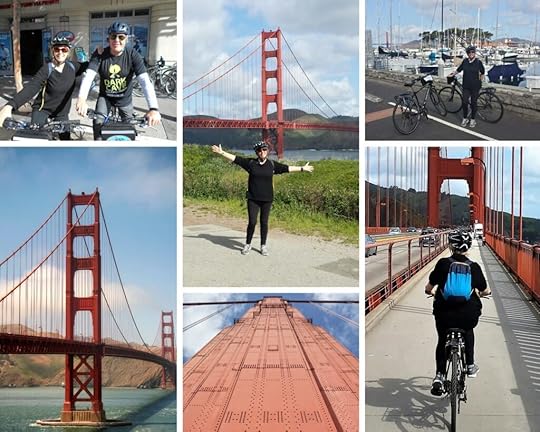 We cycled along the bike path past the beautiful marina and waterfront area, taking in the views of the bay and the bridge and of Alcatraz Island. Then once we reached the bridge, we cycled over it, and turned right around and did it again in reverse. Day 2: PM
We cycled along the bike path past the beautiful marina and waterfront area, taking in the views of the bay and the bridge and of Alcatraz Island. Then once we reached the bridge, we cycled over it, and turned right around and did it again in reverse. Day 2: PMTaking a ferry over to Alcatraz Island and exploring the famous decommissioned prison is on most people’s travel agenda when they visit San Francisco. I’m no exception. I was really excited about it and, as soon as we’d booked our flight from South Korea to San Francisco, I went online to book our tickets for Alcatraz.
I was really glad I did. I later found out that had I waited until we were actually in San Francisco to buy our tickets we would have been disappointed (gutted, actually) as tickets had all sold out for our dates.
So if you are planning to visit Alcatraz as part of a trip to San Francisco do plan ahead. Tickets are available to purchase up to 90 days ahead online so buy before you go.
This is the link to the official Alcatraz Cruises ticket site.
The Alcatraz Island Tour starts off from Pier 33 – also known as Alcatraz Landing.
It’s just a short walk from Fisherman’s Wharf. We arrived half an hour before our ferry time (as it says on the ticket) and we joined the queue. It was a pleasant 15-minute ferry ride over to the island and it was exciting to see the imposing prison getting closer and closer as we stood on the deck snapping photos.
You can take your time and stay on Alcatraz Island as long as you like and then take whatever ferry suits you back to the mainland. We listened to the visitor’s welcome talk and then walked up the hill to the prison, stopping to look at the oldest lighthouse on the Californian coastline and also to take in the poignancy of the ‘Indians Welcome’ graffiti left by the Native Americans who occupied the island in 1969 to 1971.
It was a warm, sunny, and calm day when we entered the walls of the prison that had held the most dangerous criminals in America – like Al ‘Scarface’ Capone, George ‘Machine Gun’ Kelly, Arthur ‘Doc’ Barker and probably the most famous of all Robert ‘The Birdman’ Stroud.
Burt Lancaster starred in the 1962 movie ‘The Bird Man of Alcatraz‘ about Stroud’s life in solitary confinement on D Block. Stroud was reportedly never allowed to see it.
While walking around the cell blocks, as a writer with a vivid imagination, I could easily imagine what it must have been like to have been imprisoned there in the wintertime, on cold and dark and stormy nights. It must have been horrible.
Inside the prison, the atmosphere was hauntingly oppressive.
We were told that when the wind blew towards the island, prisoners could often hear music and parties and people having fun in the city that was so close and yet so far away. That was said to be the worst torture of all for the prisoners. From my perspective, looking down from the prison wall to the water of the bay it looked as though it might be easy to escape simply by swimming away. But the currents in the bay area are said to be treacherous.
There have of course in the past been many escape attempts. The most fascinating escape attempt, in my opinion, and certainly the most mysterious, was on the night of 11 June 1962. When brothers John and Clarence Anglin and fellow inmate Frank Morris pulled off a prison break so daring it went on to inspire Hollywood thriller Escape from Alcatraz starring Clint Eastwood.
The men used blades, spoons and a drill over the course of six months to gradually dig an exit opening through ventilation ducts in their cells.
They fashioned papier-mâché models of their own heads using plaster and their own hair to make them look lifelike. Then, on the night of their daring escape, they used towels and clothing to pad out their beds and conceal their absence. To date, the escape holes they forged and the model heads are still on display at Alcatraz inside the men’s prison cells.
 Alcatraz Island Prison
Alcatraz Island Prison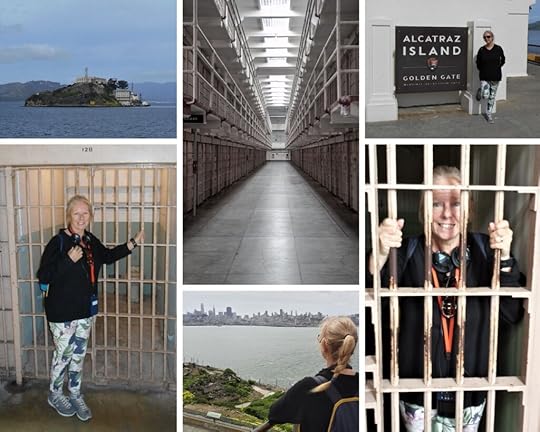 Exploring the famous decommissioned prison is on most people’s travel agenda when they visit San Francisco!
Exploring the famous decommissioned prison is on most people’s travel agenda when they visit San Francisco! I found this escape story utterly fascinating. Until fairly recently, it was believed the three men had drowned in the bay on that night in 1962 because they were never seen again. But a letter has since appeared, apparently written by John Anglin, (who would now be 83 years old) that may solve the mystery over what became of the three men.
The letter – obtained by CBS San Francisco – was allegedly sent to the city’s Richmond police station in 2013 and claims that Clarence Anglin died in 2011 and Morris in 2008.
You can read more about this letter and about John Anglin and the prisoners who escaped with him from Alcatraz in this fascinating 2018 news report in The Independent newspaper.
It was also interesting that while we were on the island, a former inmate, William ‘Bad Boy’ Baker, aged 80, who had written a book about his time in Alcatraz Prison in the 1950s entitled ‘Alcatraz – 1258’ was in the gift shop/bookshop that day to personally sign copies of his book. His prisoner number had been 1259.
Baker, who claims he learned how to counterfeit cheques in Alcatraz and ‘learned from the best’ is usually on the island every Wednesday through Friday to sign copies of his book.
I’m sure it will be an interesting read.
It was great to meet him. He’s a real rockstar of The Rock!
After taking the headset tour and listening to all the interesting information and stories of Alcatraz – and of course, having my picture taken through the bars from inside one of the tiny cells, we went outside to take a breath of fresh air and admire the city skyline of San Francisco and The Golden Gate Bridge.

Visiting Alcatraz had been all and more than I expected.
It was an amazing experience!
What do you think of my San Francisco – Fabulous Weekend Itinerary?
Have you ever been to San Francisco?
Get in touch and let me know!
Did you ride the cable cars? Did you try the clam chowder?
What’s your favourite song about San Francisco?
Have you ever been to Alcatraz Island or are you planning a visit?
Have you biked the Golden Gate Bridge or do you plan to do it?
What other bridge do you want to cross over in your lifetime?
I’d love to hear from you!
Leave a comment on this post or you can email me through my Contact Me Page or get in touch through my social media channels. I’m on Facebook as The Backpacking Housewife and I’m on Instagram as Janice Horton Writer and if you are on Twitter please do Tweet to tell me about your travel plans for this year or in the new future @JaniceHorton.
If you enjoy podcasts do listen and follow my weekly podcast Travel With The Backpacking Housewife – available on all podcast apps and channels – and also consider signing up by email to my quarterly subscriber-only newsletter (form in the sidebar and the pop up) for my writing and travel news and competitions and giveaways.

The post San Francisco – A Fabulous Weekend Itinerary! appeared first on The Backpacking Housewife.
July 25, 2021
Destination: Cairo Egypt – 5 Amazing Experiences!
What immediately comes to mind when you hear someone mention Cairo in Egypt?
Is it the current news and modern politics or ancient Egyptian history and amazing artefacts?
For me, Cairo is not so much a sprawling modern capital city, but a wistful and immersive meld of imagined adventuring and bold exploration, with its famously rich history and ancient splendour.
Join me in Cairo Egypt for 5 amazing experiences!

Growing up in the UK, I’ve had a fascination with Egypt since reading about Egyptian history and the kings and queens of Egypt, in the Encyclopaedia Britannica and Egyptian History books as a young child.
Photographs showed stunningly rich and colourful images and the text told incredible stories of adventure and discoveries of thousands of years old tombs containing ornate golden and bejewelled sarcophagus and mummified bodies and intact artefacts and countless other priceless treasures.

And, knowing all these fascinating treasures were all on display at the Museum of Egyptian Antiquities in Tahrir Square in central Cairo, had always made Egypt – and Cairo in particular – an irresistible draw and a dream destination for me.
So, while on a holiday in Sharm el Sheik, when we saw our hotel was offering private day trips to Cairo, we decided to grab the opportunity to take a break from the beach and spend 1 day in Cairo for 5 amazing experiences.
We took an early morning flight to Cairo with Egypt Air and I didn’t get a wink of sleep the night before because I felt so excited about taking this trip.
I’ve included a summary of this trip in my post ‘My 10 Greatest Travel Experiences’ but wanted to share this more comprehensive post with you to better explain all that we did on this truly amazing day in Cairo and to explain why Cairo qualifies as a Top 10 Travel Experience for me!
On the day we went to Cairo, the alarm was set for before dawn, and we made our way to the local airport at first light.
And, soon I was peering down through my oval window, to see we were flying low over the Sinai desert.
The undulating sand dunes looked like red waves on a dreamy ocean.
I even spotted a miniature caravan of Bedouin people and their camels making their way through the wavy troughs, with seemingly nothing but sand ahead of them and nowhere behind them, and I pondered over the intricacies of their lives and how they survived in such an arid landscape.
I was so mesmerised that I missed my inflight breakfast

On arrival in Cairo, we were met by our private guide for the day, who would show us around The Museum of Egyptian Antiquities and the Giza Plateau – incorporating the Pyramids at Giza, the Sphinx and the Temple of The Sphinx.
Our guide introduced himself to us as Sharif, a qualified Egyptologist. He was immediately welcoming and enthusiastic and informative about all our plans for the day. Sharif asked us how long we wanted to allocate for looking around the museum.
I explained how, for me personally, it would be the absolute highlight of our trip.
Little did I know what was in store for us… as the whole day would be a highlight in my life!
It was decided that we’d spend the whole morning in the museum of antiquities, with adequate time making sure to see the Tutankhamun Rooms and also the additional Mummy Room. Sharif then said he’d take us to lunch (he suggested The Hard Rock Café) after which we’d sail down the Nile in a traditional sailing boat called a felucca. We hadn’t realised a sailing trip was on the agenda and we were delighted.
That would leave the afternoon free to spend exploring the Giza Necropolis – just less than a 30 min drive by car out of Cairo. Sharif also promised, should we have time, he would take us to a papyrus museum to round off the day where we’d learn how to make traditional reed paper and to write in hieroglyphics!
The Adventure begins…The Itinerary1. Visiting The Museum of Egyptian Antiquities in Cairo.As I write this, I’m aware that final preparations are being made for the opening of a NEW Grand Egyptian Museum (GEM) in Cairo later in 2021. I get shivers of excitement just thinking about it!
The Main Galleries will hold over 12, 000 exhibits and the shrine of the Golden King, Tutankhamen, will display over 5600 pieces. News from Egypt is that the shrine’s ceiling is decorated with a winged sun disk and a gate to the shrine shows inscriptions and texts from the Book of the Dead!
So, if you go to Cairo to see the Egyptian antiquities yourself later in 2021 and beyond, you will no doubt get to experience the NEW GEM – which is closer to the sites at Giza – rather than the original Museum of Egyptian Antiquities (first inaugurated in 1902) in Tahrir Square, Central Cairo, the oldest archaeological museum in the Middle East.
But, of course, the treasures are still the same.
When I first saw the treasures of ancient Egypt for myself and experienced walking around the vast and crammed rooms of the museum, I have to tell you that I was so overwhelmed by it all that I burst into tears of joy as Sharif marched us along hallways and straight past the most incredible sights – gold sarcophagus and huge statues and unimaginable treasures and jewellery.
Sharif asked that we trusted him to show us all the things ‘we needed to see’ in the limited hours that we had available to us to investigate and explore the expanses of the museum. He warned that if you ambled around stopping to gaze – even for a moment on each of the 120,000 fabulous exhibits – then you would not spend many hours in the museum but many many years!
He was right, of course, and without him, we wouldn’t have been regaled with the fabulous and detailed history of each of the important pieces that he highlighted to us.
We gazed up at the colossal 83-tonne statue of Rameses 11 – the most powerful ancient ruler of Egypt – and also stopped at Sharif’s insistence to admire a tiny figurine of Khufu the Pharaoh of the Fourth Dynasty (Old Kingdom) who was the builder of the Great Pyramid at Giza. This tiny artefact at around 7 or 8 inches tall is, Sharif told us, the only complete three-dimensional object which depicts Khufu and that’s why it is so incredibly important.
Then we made it to the highlight of the exhibition. The Golden King, Tutankhamen’s room.
I had to pinch myself when I finally stood, face to face, with the king who had been crowned King of Egypt aged nine and who had died abruptly – and mysteriously – at around age 18. I stood for several minutes in awe, blinking away tears of incredibility and joy, in front of his famous golden mask.
The same mask I’d seen and read about in books when I was a child.
I studied it carefully behind the glass in which it was encased – no doubt in a carefully controlled air – to preserve the 3,000-year-old coloured paint and the sheet gold and silver, coloured glass, and jewelled embellishments on the face that Howard Carter – who discovered Tutankhamun’s intact tomb at The Valley of The Kings in Egypt in 1922 – had described as “a beautiful and unique specimen of ancient portraiture which bears a sad but calm expression suggestive of youth prematurely overtaken by death.”
Walking around the case, I inspect the back of the mask, to see imprinted into sheet gold on the collar, several vertical rows of hieroglyphic inscriptions. As a writer, I wanted to know what had been written as an epitaph to this boy king, who had lived so long ago but with whom – and through time and space – I felt strangely and spiritually connected.
Sharif explained the inscription: “Your right eye is the night boat of the sun god, your left eye is the day boat, your eyebrows are those of the Ennead of the Gods, your forehead is that of Anubis, the nape of your neck is that of Horus, your locks of hair are those of Ptah-Soker. You are in front of the Osiris [Tutankhamun], he sees thanks to you, you guide him to the goodly ways, you smite for him the confederates of Seth so that he may overthrow your enemies before the Ennead of the Gods in the great Castle of the Prince, which is in Heliopolis…the Osiris, the king of Upper Egypt Nebkheperura, deceased, given life like Ra.”
I felt so incredibly emotional seeing all the treasures of his lifetime around me.
His clothes, his shoes, his jewellery, his hair combs and other personal items. As well as his bed and his bedroom chair and occasional furniture and, of course, his ornate throne.
Finally, we moved on to The Mummy Room. In this room, to which to have to pay an entry fee, the 3000 – 3500-year-old mummified remains of 22 of the kings and queens of ancient Egypt are displayed in temperature and humidity-controlled glass cases.
Interestingly, you can stand right next to the glass cases and examine their features in some detail.
Visiting The Museum of Egyptian Antiquities in Tahrir Square, Cairo, was such a mind-blowingly incredible experience for me. And now, with the Grand Museum of Egypt soon to be opened at Giza – I’m excited about the new building – but I’m also feeling grateful that for one wonderful day in my life, I was able to see and experience being inside the original over-crowded and incredibly over-whelming original home to a collection of Egyptian treasures that I know I’ll absolutely treasure forever.
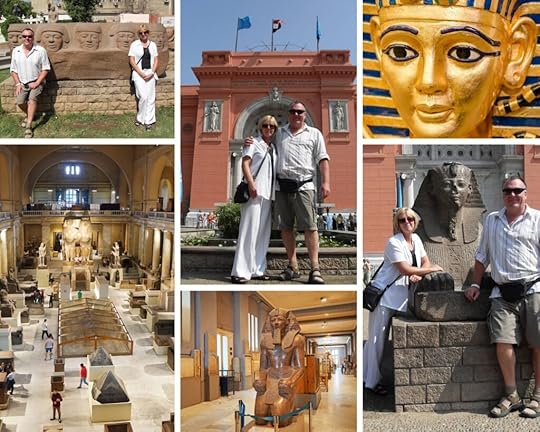 2. Sailing The Nile On A Traditional Egyptian Felucca.
2. Sailing The Nile On A Traditional Egyptian Felucca.A felucca is a traditional Egyptian low wooden sailing boat with a canvas sail that has been used on The Nile since ancient times. Today it is an iconic image on the mighty river and they are still crewed by local sailors. Sailing on The Nile on a felucca is a wonderful and relaxing way to spend time in Cairo – especially in the heat of the early afternoon and after all the walking and the excitement in the museum. It also feels so in keeping with the theme of history and tradition and it seemed to me that there was no denying the authenticity of the boat or our boatman.
Feluccas are available in lots of sizes and so cater for just a few tourists or larger tourist groups.
Sharif had organised a small private boat for an hour of sailing and there was just the four of us abroad. My husband and myself, Sharif, and our friendly boatman – Mohammed.
After lunch at The Hard Rock Café in downtown Cairo, we headed down to the banks of the Nile and boarded the open deck boat of a felucca. We sat on the forward section, shaded from the midday sun by the large single billowing sail, to enjoy the views on both banks of the Nile.
It was a wonderful experience and one I would highly recommend to you!
 3. Exploring the Great Pyramids at Giza in Egypt.
3. Exploring the Great Pyramids at Giza in Egypt.After exploring the Museum of Egyptian Antiquities in downtown Cairo and sailing on the Nile in a traditional felucca sailing boat, our guide, Sharif, drove us out of town and to the Giza Plateau also known as the Giza necropolis, on the edge of the desert, to investigate The Great Pyramids at Giza.
All were built during the Fourth Dynasty of the Old Kingdom of Ancient Egypt (2700-2200 BC).
The Great Pyramid is the oldest of the Ancient Wonders and the only one still in existence.
My excitement knew no bounds and I actually shrieked as I caught my first glimpse of the three famous primary pyramids of Khufu, Khafre, and Menkaure; the last massive remaining wonders of the ancient world, silhouetted by the sun from our car.
We parked up on the sand and walked a short distance, in the incredible heat of the afternoon, right to the base of the giant block structures to pose for lots of photos that Sharif absolutely insisted on taking using my own camera.
The best thing we did that day was to employ Sharif to guide us.
He was so knowledgeable – not only of Egyptian history – but he had the most incredible organisational skills and he always knew exactly where to take us for the best experiences.
I saw that he also spoke discreetly to the pyramid guards and somehow managed to convince them to allow us to take our small camera into the pyramids with us even when there was a big sign stating ‘no cameras inside’. I’m guessing we only got away with it as there were few other tourists that day.
Did I mention that it was HOT? Our visit was in August and it was over 40 degrees plus C!
I suppose the benefit of going there in the summer and during the hottest part of the day meant that there were not as many other tourists around. Everyone else had, I imagine, seen the pyramids in the comparatively cooler part of the morning and then headed to the air-conditioned museum in the heat of the afternoon.
Squeezing into the narrow shaft and climbing down a sloping wooden ladder into the pyramids – all the way down to the crypts at the bottom – felt like being baked in a pizza oven. But it was worth the sweltering discomfort and feelings of claustrophobia to be so deep inside the pyramid.
I would have hated to have been there when it was busy as the narrow shaft only allowed for one way traffic.
We explored each of the pyramids in turn, buying tickets on-site and squeezing into the narrow chutes leading down – and then sometimes levelling off – before going down again into the tomb.
Outside the pyramids, Sharif insisted on taking lots and lots of wonderful and often quirky photos of us with my camera!
And, as if seeing the Pyramids wasn’t enough, Sharif had arranged for one of the guards at the plateau to open up a locked wooden door at the bottom of some steps in the sand, to allow us entry into what Sharif described as ‘The Engineer’s Tomb’.
This secret tomb was, we were told, a gift from the Pharaoh Khufu to his chief engineer of the Great pyramid and an eternal resting place for him and his family. And, as we waited in great anticipation for the wooden door to the chamber to be unlocked, I saw there were rows of perfectly preserved hieroglyphics on a stone above the door. To say I was excited was an understatement!
It was quite clear to us that this crypt was not normally open nor available to tourists.
Inside the crypt, it was low and narrow and deep, with stone columns decorated with more perfectly preserved hieroglyphics holding up the roof. On the walls were carved pictures and statues of the Engineer and his entire family. It felt so very special and sacred to be inside this mausoleum.
Even though I’m a writer, I hardly know how to find the words to explain to you how I felt that day – experiencing the ancient wonders of Egypt with my own eyes – touching them with my own hands.
It was then and still is one of the most special and emotional days in my entire life.
Standing in front of the very same sights and antiquities that I’d gazed at in the pages of history books as a child was, at times, just too much – and I spontaneously wept with wonder and joy several times that day – simply because I couldn’t contain my overwhelming feelings on being faced with such incredible history and the achievement of a lifelong dream.
 4. The Sphinx and the Sphinx Temple at Giza.
4. The Sphinx and the Sphinx Temple at Giza.The Great Sphinx at Giza is considered an icon of the Ancient Egyptian civilisation. The giant structure features a lion’s body and a human head adorned with a royal headdress. The statue was carved from a single piece of limestone and likely dates from the reign of King Khafre (2575 2465 BC) and is said to depict his face. Although, many believe that the monument is much older and predates King Khafre and it is of the jackal god Anubis, the god of funerals.
There is certainly still an air of the unknown and a mystery around its origins.
And, to be faced with this amazing and famous structure, is awe-inspiring!
Sharif once again took my camera from me and insisted on taking lots more photos and he took great pride and skill in taking the ones of me apparently kissing the Sphinx on its lips!
Right in front of the Sphinx, an open structure was erected, and some archaeologists consider it to be the Temple of The Sphinx. Others say the temple is dedicated to the God Ra (Re), the famous Sun God of the Egyptians. It’s a special and spiritual place to behold and I found myself silently thanking the sun, the stars, and the whole universe, for granting me this truly momentously special day in my life.
And, while we were at the temple, having our photos taken peering out from and between the standing columns to appease Sharif, who was still insisting on taking more photo mementoes of the fabulous day (for which I am now truly grateful) we saw that a white feather had floated down from above and landed at our feet.
And, in such a special place, I felt it was a sign that my grateful thanks had been acknowledged.
 5. The Egyptian Papyrus Museum.
5. The Egyptian Papyrus Museum.To round off our day, before Sharif dropped us off back at the airport for our evening flight back to Sharm El Sheik, he took us to the government-approved Papyrus Museum, also known as The Hassan Ragab Papyrus Institute.
The Late Dr. Hassan Ragab opened his Papyrus Institute in 1968 to re-establish the authentic papyrus ancient technique. The museum/institute provides visitors with a demonstration on how the papyrus plant was turned into a paper material for writing on by the ancient Egyptians that has survived for thousands of years.
There is no entrance fee but once inside the museum you are also encouraged to have a go at making papyrus paper yourself and you are sure to want to buy a souvenir from the shop.
We bought three beautiful papyrus parchment paper featuring our three son’s names in hieroglyphics.
The museum is located just outside the centre of Cairo on the west bank of the river Nile and between the Cairo Sheraton and the University bridge.

Are you planning to visit the New Grand Egyptian Museum sometime in the future?
Have you ever been to The Museum of Egyptian Antiquities in Cairo?
Have you ever visited the Pyramids and the Sphinx at Giza?
What do you think of my suggestions for 1 day in Cairo Egypt and 5 Amazing Experiences?
Do you have any experiences you might add?
I’d love to hear your stories if you have been to Cairo and about your dream and plans of travelling there if it’s still on your bucket list. Do please get in touch. I’d love to hear from you!

Email me through my Contact Me Page on my website.
Or get in touch through my social media channels.
I’m on Facebook as The Backpacking Housewife and I’m on Instagram as Janice Horton Writer and if you are on Twitter please do Tweet to tell me about your travel plans for this year or in the new future @JaniceHorton
And do also come and travel with me on Travel With The Backpacking Housewife Podcast.
Subscribe to my podcast and follow for inspiring and informative new episodes each week in which I’ll be discussing ways to plan for and to prioritise travel and adventure in our lives!
The post Destination: Cairo Egypt – 5 Amazing Experiences! appeared first on The Backpacking Housewife.
July 7, 2021
My 10 Greatest Travel Experiences
Trying to whittle down all the amazing travel experiences I’ve had during the years since the backpacking husband and I decided to sell everything we owned to travel the world in our midlife and beyond, down to just my 10 Greatest Travel Experiences, has been a delightful exercise in travel nostalgia after living in just one place and travelling nowhere due to the pandemic.
I did a brainstorming session that resulted in a list of dozens of wonderful travel experiences!
How to choose just 10? How could I not include our trip to The Grand Canyon? That time we sailed in a junk across Hong Kong Harbour. Cycled across the Golden Gate Bridge. Or went hard hat diving in Mauritius. Or the time we travelling across Seven Mile Bridge to the Florida Keys? Got married again in Las Vegas with Elvis. Got matching half sleeve travel tattoos in Malaysia. Flew in a seaplane across the atolls of the Maldives. Climbed tropical jungle waterfalls. Or sailed on boats in the Caribbean Sea. Or explored South Korea. Or went up to the top of the Petronis Towers in Kuala Lumpur? Or lived in a 500-year-old chateau while housesitting in France?
Maybe the list of My 10 Greatest Travel Experiences should be 100 and not 10?
Then I might also give a shout out to my favourite countries – out of the 56 that we’ve explored to date – and include all the fabulous cities and amazing places we’ve travelled to that are now embedded so deeply in my heart?
Well, I suppose because this list isn’t about my favourite places.
This list is about the top 10 greatest experiences that I’ve had while travelling.
My 10 greatest travel experiences are all about feelings and emotions rather than locations and destinations…
I have finally been able to whittle through hundreds of amazing experiences, and somehow, I’ve managed to produce a list of My 10 Greatest Travel Experiences to date. But you should know that they are not listed in any particular order of merit.
This is because every one of these travel experiences has been chosen for the mind-blown pinch me kind of feeling that each evoked. Because while I was there – experiencing these things – I knew without any doubt in my mind that I was living in a very special moment; a unique time in my life that I would forever hold special.
And, when I’m old – if I’m able to achieve old age and still have my memories intact – then I hope I will be able to close my eyes and bring to mind these experiences I so carefully and consciously imprinted into my heart.
I also realise that I haven’t written full posts yet for this website on most of these 10 Greatest Travel Experiences.
How could that be? Well, now that I have collated this list to date, I will definitely want to write more about and to expand on each of these 10 Greatest Travel Experiences with you in much more detail here on my website and on my Travel With The Backpacking Housewife Podcast at some point in the very near future.
So, do lookout for new posts, and why not subscribe to my mailing list for a newsy travel email (with a subscriber giveaway) just once a month? There is a signup link in the sidebar and you may also see a pop-up box as you leave.
So here we go: My 10 Greatest Travel Experiences to date!1: Volunteering with Turtle Conservation.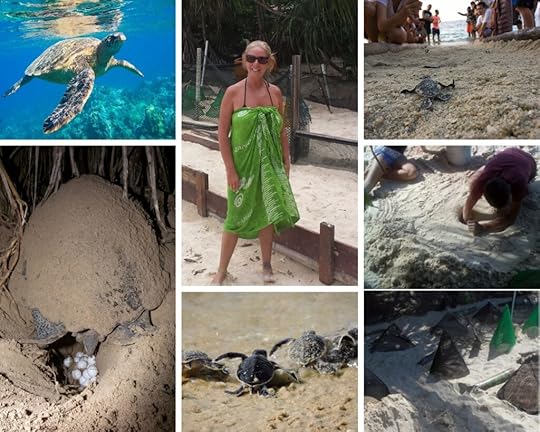 Turtle Conservation experience at Bubbles Resort Malaysia
Turtle Conservation experience at Bubbles Resort MalaysiaThere’s a cluster of small and remote coral islands, called the Perhentian Islands, about 10 miles off the north-eastern coast of Malaysia. We took a short (1 hour) flight from Kuala Lumpur to Kota Bharu on the coast and then a boat over to the islands to stay for a week in a small thatched hut on a half-moon shaped white sand beach in a cove only accessible by boat as the beach and the resort is totally surrounded by jungle.
The resort on that beach is an eco-resort called Bubbles and it’s a 5-star PADI Dive Centre.
Because Bubbles Resort is located on a nesting beach for endangered Green Turtles they also have a turtle and reef experience and conservation project that you can be part of during your stay.
We stayed for a week. The Backpacking Husband was diving every day and I volunteered on the nesting turtle conservation and I have to say that it was one of the greatest experiences of my life.
As I said, the resort is a 5-star PADI dive centre, but it is not a 5-star holiday resort. It is in fact quite basic in that it is unspoiled and laid back and relaxed and the rooms are clean but if you like a bit of luxury in your life then this might not be the destination for you.
Bubbles Resort is totally wildlife and turtle-friendly and it has a ‘house’ coral reef.
The beach is off-limits after dark unless you are on beach patrol to spot turtles coming ashore to lay their eggs and there are only red lights allowed at night rather than white lights because turtles are unable to detect red light.
During that amazing week, I saw monkeys and lemurs in the trees. Lizards in the jungle. I got to swim in warm clear waters on a coral reef with tropical fish and with turtles. I got to go out on beach patrol at night to see huge nesting green turtles coming ashore under the moon to lay their eggs at the top of the beach. I got to see turtle nests erupting and hundreds of baby turtles emerging from the sand to run on their tiny flippers across the beach to the sea.
I went to several lectures to learn about turtle conservation, and I was amazed to learn that female turtles are around 30 years old when they first return to the beach where they had been born, to lay their eggs. I also learned more about the important work being done at Bubbles Resort with their turtle conservation and reef preservation projects.
The experience, for me, was both life-changing and life-affirming and absolutely one of My 10 Greatest Travel Experiences.
It’s a week I’ll never forget because it was so truly special and extraordinarily memorable.
I’ll forever remember sitting quietly on the beach at night under a full moon, on the cooling sand, listening to palm trees swaying, waves lapping against the shore, and a huge turtle ‘thwacking’ the sand with her flippers as she carefully excavated her nest in which she would lay around a hundred eggs – that three months later, having been carefully guarded against predators by the conservation staff at Bubbles – would hatch with tiny newly born Green Turtles.
Read my full post on Green Turtle Conservation in Malaysia
2: Seeing Orangutans in the wild in Borneo. Orangutan Rehabilitation experience in Borneo
Orangutan Rehabilitation experience in BorneoWhile exploring in Malaysia, we travelled from Kuala Lumpur (KL) over to the rainforest city of Kota Kinabalu (KK) the capital city of Sabah and the gateway into Borneo. We were looking to experience Orangutans in the wild. From KK we travelled across the country to Sandakan and to the Sepilok Orangutan Rehabilitation Centre in North Borneo.
The centre, in a reserve of virgin lowland equatorial tropical rainforest, was set up by an Englishwoman called Barbara Harrison in 1964 and was the first centre in the world to dedicate itself to the rehabilitation of orphaned orangutans that are living wild in the reserve.
The Sepilok Orangutan Rehabilitation Centre also provides care for dozens of other wildlife species. Some of the other animals which have been treated at the centre include sun bears, gibbons, and elephants.
I’d read so much about the reserve and I have great admiration for the important work they are doing in the rehabilitation of orphaned, especially concerning orphaned and injured (often due to illegal logging and deforestation) and ex-captive orangutans, that had been kept as pets.
It was a big dream of mine to visit and see the successfully rehabilitated Orangutans enjoying their life in the wild.
On the day, we attended the visitors centre and watched a short movie about the work done at the centre.
I will admit to you that I wept with sorrow at seeing the film showing the distressing, indeed harrowing, circumstances that led to how some of the orphaned orangutans had arrived at the centre and then I wept with joy, at seeing the care and transformation that would eventually lead them to rehabilitation and return to the wild.
We walked through the rainforest trails, craning our necks in the hope of seeing Orangutan (meaning: the man of the forest) high above us in the ancient tree canopy. We spent time at the nursery, where the young orangutans are cared for and taught the climbing and foraging skills they will need to live in the wild. Skills they would have – and should have – been taught by their mothers over a period of around 10 years because Orangutans spend the longest time (other than humans) accompanied by and learning life skills from their parents.
Then, in the afternoon, we made our way to the feeding platform where the rangers provide fruit and sugar cane to provide the rehabilitated orangutan with a free feed. Feeding times are at 10am and 3pm. Because the Orangutans are wild, sightings are not guaranteed, but we were soon treated to a close-up experience with the Orangutans when many suddenly appeared, swinging in from the trees and branches, to land on the platform and claim their sweet treats. It was wonderful!
As well as the feeding station, the outdoor nursery is open twice a day and is where you can observe some of the young orangutans playing and learning in their various stage of rehabilitation through Sepilok’s protected specialist programme.
Our day spent at Sepilok Orangutan Rehabilitation Centre was an amazing and incredible experience!
3: Visiting The Museum of Egyptian Antiquities in Cairo.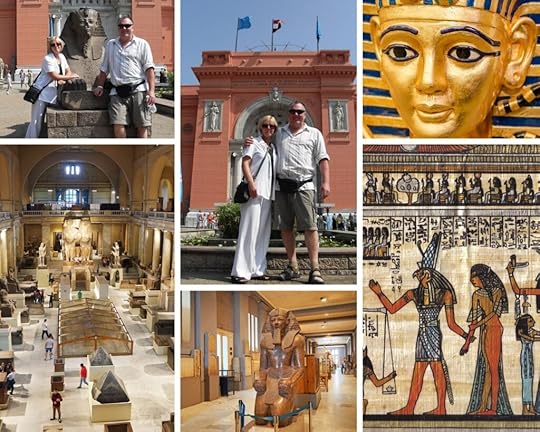 Visiting The Museum of Egyptian Antiquities in Tahrir Square, Cairo, Egypt.
Visiting The Museum of Egyptian Antiquities in Tahrir Square, Cairo, Egypt.As I write this, I’m aware that final preparations are being made for the opening of a NEW Grand Egyptian Museum (GEM) in Cairo. I get shivers of excitement just thinking about it!
The Main Galleries will hold over 12, 000 exhibits and the shrine of the Golden King, Tutankhamen, will display over 5600 pieces. News from Egypt is that the shrine’s ceiling is decorated with a winged sun disk and a gate to the shrine shows inscriptions and texts from the Book of the Dead.
When I first saw the treasures of ancient Egypt for myself and experienced walking around the Museum of Egyptian Antiquities in Cairo (first inaugurated in 1902), I was so overwhelmed by it all that I burst into tears of joy.
We’d hired a guide for the day to show us around the museum, the oldest archaeological museum in the Middle East and with the largest collection of Pharaonic antiquities in the world, because we’d been warned that if you walked around it without a guide or a plan, then stopping to gaze – even for a moment on each of the 120,000 fabulous exhibits – then you would not spend many hours in the museum but many many years!
Our guide, Sharif, a qualified Egyptologist, marched us through the hallways and straight past the most incredible sights – sarcophagus and statues and unimaginable treasures and gold and jewellery.
But Sharif had asked us that we trust him to show us all the things ‘we needed to see’ in the limited hours that we had available to us to investigate and explore the expanses of the museum.
He was right, of course, because without him we wouldn’t have been regaled with the fabulous and detailed ancient history of each of the important pieces that he’d highlighted. We might not have made it to the Mummy Room or the highlight of the exhibition – the Golden King Tutankhamen room, in which I stood, face to face with the king who had been crowned King of Egypt aged nine and who had died abruptly – and mysteriously – at around age 18.
I could hardly believe I was looking at the same mask and the very same antiquities I’d read about in books when I was a child. I stood for several minutes in awe in front of his famous golden mask and then I looked around me to see all the treasures of his lifetime uncovered in 1922 by Howard Carter.
Visiting The Museum of Egyptian Antiquities in Tahrir Square, Cairo, was such a mind-blowingly incredible experience for me. And now, with the Grand Museum of Egypt soon to be opened at Giza – I’m excited for the new building – but I’m also feeling grateful that for that one special day in my life, I was able to see and to experience being inside the very over-crowded and incredibly over-whelming original home to a collection of Egyptian treasures.
I know I’ll absolutely treasure the experience forever.
4: Exploring the Great Pyramids at Giza in Egypt.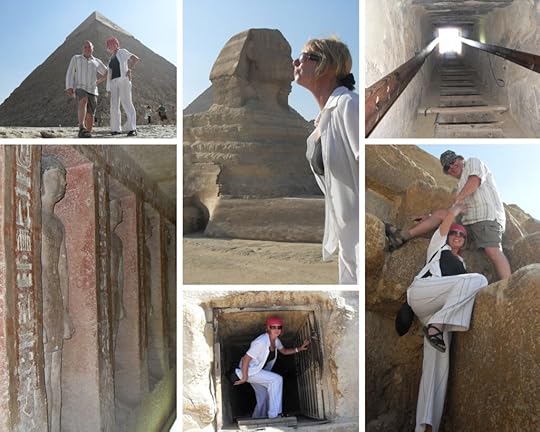 Exploring the Pyramids at Giza in Egypt.
Exploring the Pyramids at Giza in Egypt. After exploring the Museum of Egyptian Antiquities in downtown Cairo, our guide, Sharif, drove us out of town and to the Giza Plateau on the edge of the desert, to investigate the Pyramids and the Sphinx. All were built during the Fourth Dynasty of the Old Kingdom of Ancient Egypt (2700-2200 BC). The Great Pyramid is the oldest of the Ancient Wonders and the only one still in existence.
My excitement knew no bounds and I actually gasped aloud as I caught my first glimpse of the pyramids from our car.
We parked up and walked across the sand right to the base of the giant block structures and we posed for lots of photos – which Sharif absolutely insisted on taking!
Perhaps the best thing we did that day was to employ Sharif to guide us through the museum and to the Giza Plateau. He was friendly and enthusiastic and so knowledgeable – not only on Egyptian history – but he always knew where exactly to take us for the best experience. He also spoke discreetly to the pyramid guards and somehow managed to convince them to allow us to take our small camera into the pyramids with us even though I’d spotted a big sign saying ‘no cameras inside’.
I’m guessing that we were only allowed to get away with it because there weren’t many tourists that day.
Did I mention that it was HOT? It was over 40 degrees plus C!
Squeezing into the narrow shaft and climbing down into the pyramids – all the way down to the crypts at the bottom – I imagined felt akin to being baked in a pizza oven. But, of course, it was worth the sweltering discomfort and feelings of claustrophobia to be so deep inside the only remaining wonder of the ancient world.
Although, I would have hated to have been there when it was busy with lots of visitors, as the narrow shaft only allows for one way traffic.
And, as if seeing the Pyramids and the Sphinx at Giza wasn’t enough, our guide Sharif arranged for one of the guards at the plateau to open a locked wooden door at the bottom of some steps in the sand, to allow us entry into what Sharif described as the Engineer’s Tomb.
This secret tomb was, we were told, a gift from the Pharaoh Khufu to his chief engineer – an eternal resting place for him and his family. As we waited in great anticipation for the wooden door to the chamber to be unlocked, I saw rows of perfectly preserved hieroglyphics on a stone above the door.
To say I was excited was an understatement.
It was quite clear to us at the time that this crypt was not normally open or available to tourists…
Inside the Engineer’s crypt, it was low and narrow and deep, with stone columns decorated with more of the perfectly preserved hieroglyphics holding up the roof. On the walls were carved pictures and statues of the Engineer and his entire family. It felt so very special and sacred to be inside this mausoleum.
Even though I’m a writer, I don’t really know how to find the words to explain to you how I felt that day – experiencing the ancient wonders of Egypt with my own eyes – touching them with my own hands.
It was and still is one of the most special and emotional days in my entire life.
Standing in front of the very same sights and antiquities that I’d gazed at in the pages of The Readers Digest books as a child was, at times, just too much for me and I spontaneously wept with wonder and joy several times that day. Simply because I couldn’t contain my overwhelming feelings on being faced with such incredible history.
As well as exploring The Museum of Egyptian Antiquities in Cairo and the Giza Pyramid Complex and the Sphinx and the Sphinx Temple, we visited a papyrus (Egyptian reed paper) museum and we sailed down the Nile in a traditional sailing boat called a felucca.
Clearly, I have to write a whole post on our Egyptian experience so I can go into more detail about what we saw there and to show you all my photos!
5: Living on a Caribbean Island that was hard to leave.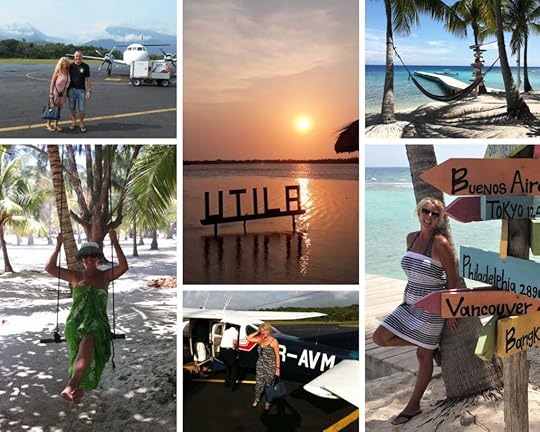 Island Life On Utila Honduras so idyllic I didn’t want to ever leave.
Island Life On Utila Honduras so idyllic I didn’t want to ever leave.When we first set off on our travels, we went to explore the islands of the Caribbean. As you might imagine, it was fabulous.
We eventually found ourselves in the Eastern Caribbean, in The Bay Islands, just off the coast of Honduras.
The smallest of the three inhabited islands there is called Utila and I wrote about it in my post ‘A Secret Place In The Caribbean’. It felt like not too many people knew about it. It felt like we’d discovered a secret place.
Utila is a tiny tropical island paradise sitting on the Meso-American reef – the second largest coral reef in the world – tucked away in a sheltered bay where the water is warm and clear.
There is a song on YouTube about Utila and the verse includes: ‘If you come to Utila, you’ll never want to leave.’
The first time we visited Utila, we stayed for six months (we left for a few days after three months, as required by our visa on arrival stamp, but then went straight back again simply because we really didn’t want to leave.
I remember how we’d first arrived to find the house we’d rented double booked but we didn’t stress about it – we soon found a room to stay in for a couple of nights – and then another place to rent.
We found a little wooden Caribbean style house on stilts and with a porch to rent near to the beach.
During those blissful six months, the scuba diving backpacking husband did his PADI Dive Master course at a dive shop called Gunter’s Ecomarine. The people there so warm and friendly – even to middle-aged travellers like ourselves – that they soon became good friends and like family to us and the dive shop on the dock soon became our second home.
Days were spent diving (the backpacking husband) writing romantic adventure novels on the porch in our little house or reading in a hammock under a mango tree (me) and we also had many days out in boats on the reef and lazing around in the sun on the beach and drinking rum at beach bars into the evening with our lovely island friends.
Island life was fun and fabulous and so blissfully wonderful.
I’ve heard Utila likened to the ‘Key West of the 1950’s’ and it’s true that the island has a kind of timeless but also unpretentious laid-back vibe about it.
Over our years of travelling the world, we’ve been back to Utila many times, sometimes staying for the three months allowed by the arrival visa and sometimes for six with a visa run in the middle.
Not that it’s easy to get to Utila from Europe. We usually factor in at least one overnight stopover in either the USA or Honduran mainland and it involves many flights – each plane getting smaller.
Until we eventually arrive on the island’s tiny airstrip in a four-seater Cessna.
We were heading to Utila when the pandemic hit and our plans for summer 2020 were put on hold, and it’s the first place we plan to go in the early part of 2022, when travel becomes possible again.
And, I know when we finally get back to Utila, that we will never want to leave.
You can read more about my island experience on Utila in my post ‘A Secret Place In The Caribbean‘.
6: Exploring Angkor Wat in Cambodia. Experience of the Angkor Archaeological Park and the sites of Siem Reap Cambodia was truly wonderful.
Experience of the Angkor Archaeological Park and the sites of Siem Reap Cambodia was truly wonderful. I’m not a religious person but I will admit to being spiritual and I absolutely love an old temple.
So, given the opportunity to spend a week in Cambodia to explore Angkor Wat – the largest religious structure in the world – I was beyond thrilled and excited.
Angkor Wat was built by the Khmer King Suryavarman II in the first half of the 12th century, around the year 1110-1150, making Angkor Wat almost 900 years old.
It was named a UNESCO World Heritage site in 1992.
Angkor Wat lies 5.5 kilometres (3.4 mi) north of the town of Siem Reap and is the most famous temple at the Angkor Archaeological Park – a park that stretches over 400 square kilometres and contains some of the most famous temples in the world, including Ta Prohm (the incredible location of the Lara Croft movie and The Bayon (iconic temple of many faces) Temple.
There are also literally dozens more stunning ancient temples to be explored outside of the park.
We flew from Kuala Lumpur, Malaysia, to Siem Reap, Cambodia. We booked a hotel on the recommendation of a friend.
And, my number 1 tip and by far the best and most affordable way to get around and to see all the sites, and to avoid too much walking in the incredible heat – is to hire a tuk-tuk and driver for the day.
Your tuk-tuk driver will take you to the archaeological park office to buy your tickets, whisk you around to all the temples, and wait for you while you explore the sites at your leisure and own pace.
We actually hired a tuk-tuk and a wonderful friendly driver (from outside our hotel) for several days.
We visited Angkor Wat on our very first day and then saw a magical medley of temples around the Angkor Archaeological Park on days two and three. I was blessed by a monk – several times actually and even danced with some Khimar (Apsara) dancing girls – and it was incredible.
It was also awe-inspiring to be surrounded by all these incredible and intensely spiritual temple sites – some of them in the middle of the steamy jungle – with their giant tree roots growing through the centuries-old stone structures!
We followed this with a ‘pool and spa day’ to relax and recover from our exhaustion from all the walking.
Then, we continued on our explorations with our tuk-tuk and driver on a trip out to a war museum.
We finalised our incredible week and what felt to me like a magical time in Cambodia by experiencing the Floating Village on Tonle Sap Lake. Taking a boat out to see how a whole community lives on the lake in floating houses, floating shops, and even animals and chicken coops on rafts is an incredible sight and an experience I heartily recommend to you.
We even had our lunch at a floating restaurant!
Our experience of Angkor Wat and the Angkor Archaeological Park and the sites of Siem Reap in Cambodia was truly wonderful. It’s such a special place and the Cambodian people are genuinely kind and friendly to visitors.
A unique and memorable time I’ll forever treasure in my heart.
7: Travelling through jungle on the North Borneo Railway steam train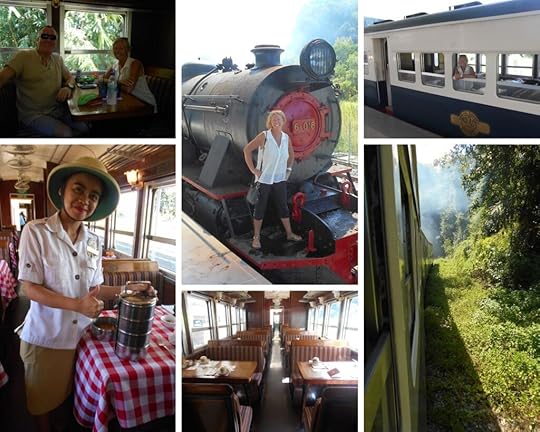 All Aboard The North Borneo Express for a fabulous old train experience!
All Aboard The North Borneo Express for a fabulous old train experience!We had the most amazing travel experience travelling into the heart of Malaysian Borneo on a fabulous and romantic old steam train re-living memories of a bygone era of old colonial times.
We were greeted on the station platform by friendly staff dressed formally in colonial style uniforms complete with a ‘pith’ style hat. The train – an old Vulcan vintage steam engine manufactured by the Vulcan Foundry Ltd in Lancashire, UK – is one of the last of an entire fleet of steam locomotives that have travelled through Borneo since the 1880s.
The carriages have been refurbished inside and out and have a gleaming cream and teal green livery.
Inside, the carriages are furnished with upholstered seating and oakwood tables and lamps from the vintage colonial era, providing a truly authentic and nostalgic experience of steam train travel in the early 1900s.
We were given travel ‘passports’ as we boarded our carriage and they were stamped at every town that we stop at along the way. We took our seats, and it was exhilarating to hear the departure whistle blow and to feel the train start to move out of the station.
Once on our way, we had the benefit of a fragrant breeze blowing in through the train’s open windows as we chugged along the coastal route, catching glimpses of the South China Sea.
En route – a journey of some 36 miles – we also went through villages, tunnels and steamy jungle.
We passed temples, rice fields, plantations, and we waved at cheering people as we chugged along.
It’s a half-day trip to ride from Kota Kinabalu to Papar, stopping off at several towns and hopping off at stations along the way, to sightsee and to shop in local markets and to engage with the friendly people and to enjoy all the unique and special places all along the rail route.
The North Borneo Railway runs two weekly return departures on a Wednesday and a Saturday all year round. The train leaves at 9.30am from Tanjung Aru Station at Kota Kinabalu and shortly after departure you are served a continental breakfast and a traditional ‘Tiffin Lunch’ on the way back.
Our fabulous trip onboard the North Borneo Express was a travel experience I will never forget.
8: Island Hopping from Thailand to Malaysia We spent a month backpacking and tropical island-hopping along Thailand’s Andaman Sea.
We spent a month backpacking and tropical island-hopping along Thailand’s Andaman Sea. One of the most memorable and greatest travel journeys I’ve ever experienced was the time we travelled by various types of boats and spent a month slowly backpacking and tropical island-hopping our way all along the islands off Thailand’s Andaman Sea.
We began our trip by taking a longtail boat from Krabi on the mainland to Railay Beach – only accessible by boat -where we stayed for two nights. From Railay, we moved onto Koh Lanta, the island of sea gipsies and the largest island in the chain, for a couple of weeks.
From Koh Lanta (koh meaning island) we moved south, spending an assortment of nights on the small tropical islands of Koh Ngai and onto Koh Kradan – stopping off to explore the emerald cave at Koh Muk – all by longtail boat – and then by a bigger boat for the distance involved onto Koh Bulon.
Some of the islands on this archipelago are more popular with tourists than others due to the variety of accommodations – budget, mid-range, or luxury – and availability.
As accommodation is usually limited it is always best to book ahead of your arrival especially in high season – from November through to March. We travelled in November and I booked all but one of our hotels via Booking.com except for our stay on Koh Bulon at the Bulone Resort which had to be booked directly with the hotel. I think, for this reason, not many people seem to know about it.
When our boat arrived at Koh Bulon, dropping us off into the shallow water next to the arc of white sand beach with a backdrop of verdant jungle and swaying palm trees, we were the only ones to get off and we were amused to see everyone on the boat in jaw-dropped awe at seeing the island.
‘Oh wow – where is this?’ we heard them ask and we just replied. ‘This is paradise’.
We left Koh Bulon after four nights and travelled on by speedboat to the border island of Koh Lipe (where immigration is a hut on the beach) to reach our final destination of Langkawi, Malaysia.
We explored the island of Langkawi for a week before flying onto the capital city of Kuala Lumpur.
The whole experience of island hopping down the Andaman Sea in Thailand was heavenly. Travelling from one paradise island to the next. Arriving by traditional long-tail boat or motorboat and mostly being dropped straight onto the beach, or as close as our boat could get to the shoreline, which usually meant us climbing out into thigh-deep crystal-clear and bathwater-warm water with our backpack held high as we waded ashore.
The few hotels on these islands are on the beach, set back under palm trees, amidst fragrant tropical gardens. There are palm-thatched tiki bars on the beach and the views are of clear blue water lapping the white sand beach and sandbanks a little way out revealed by a low tide, and a horizon line littered with giant and majestic limestone rocks sticking up from the sea, green with tropical vegetation that is breathtaking to behold and often resemble the shapes of animals and birds.
If you ever dreamed of an authentic tropical island-hopping holiday then this is absolutely it.
9: Chiang Mai to Bangkok by old train with my best friend.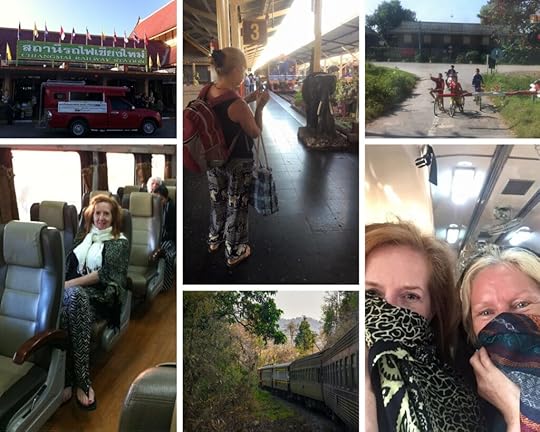 N
ot the most comfortable journey but the most memorable way of travelling through Thailand with my best friend!
N
ot the most comfortable journey but the most memorable way of travelling through Thailand with my best friend! While I was living in Thailand – on the island of Koh Tao – my lovely best friend came out from the UK on holiday for a couple of weeks. As she has pale skin and red hair, being in the sun on the beach all day wasn’t really going to be her thing. So we decided to leave the island for a week by ferry, to travel first to Koh Samui where we could fly north to Chiang Mai, where it would be cooler and there would be lots of sightseeing and temple bagging to do in the ancient walled city.
We had a truly fabulous and memorable time in Chiang Mai and when it was time to leave, we decided that instead of taking the one hour flight back to the coast, we’d take the train instead.
I informed my dear and somewhat sceptical friend that we would be taking an interesting and authentically Thai journey on an old and iconic train and that it would be a great experience.
Little did I know that it would certainly be authentic to the extreme. That the 12 hours from seeing the sunrise in Chaing Mai to seeing the sun setting over Bangkok would seem like forever. That the toilet on the train would soon stink out the whole carriage and the lunch provided to us would be a green Thai curried fish head complete with bulging eyes!
But what we both knew straight away, from the first moment we boarded that early morning train, was that we would be talking (and laughing) about that incredible journey for the rest of our lives!
It is actually a journey that can no longer be replicated because the train that now runs from Chiang Mai to Bangkok’s station – a journey that took 12 hours – has now been replaced by a modern and more luxuriously appointed express train.
You can find out more about the current journey, train times and how to book trains in Thailand from Seat61.com
Book your train tickets in advance on the recommended online site at: 12GoAsia
The rolling stock before then, that we experienced (and endured!) was an old train originally imported from Vietnam with original box style carriages and hard straight-back vinyl seats, with air-con provided by a ceiling fan (if you were lucky).
Also, the arrival station at Bangkok is now (or soon to be) diverted away from the old and architecturally magnificent Hua Lamphong Station to the ultra-modern brand new Bang Sue terminal.
So, although looking back on our iconic and authentic 12-hour Thai train travelling adventure on that old slow and rattling train, wasn’t the most comfortable journey I’ve ever taken. It really was the most memorable way of travelling through Thailand with my best friend that I could ever experience!
10: Island hopping in the Seychelles.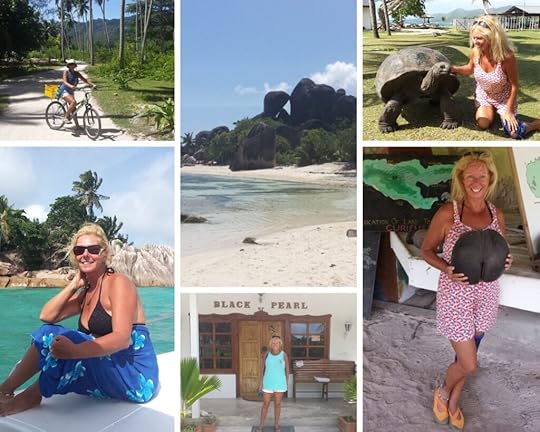 Our impromptu ‘island hopping’ experience in Seychelles was both memorable and truly great!
Our impromptu ‘island hopping’ experience in Seychelles was both memorable and truly great! My final greatest travel experience to share with you is the time we went on an island-hopping adventure in Seychelles.
The Islands of Seychelles are located in the Indian Ocean, off the coast of Africa, and these islands often called the most beautiful in the world and are a tropical dream destination high on a bucket list for many of us.
Except, our trip to Seychelles happened quite by chance.
Having sold our home, our cars, and all our possessions to travel long-term a year or so before, we had been travelling the world and had headed back to the UK as arranged for a friend’s summer wedding. Our flight (from Central America via the USA) had brought us back two weeks before the wedding day.
So, after shopping to get kitted out for the wedding, we were looking for somewhere to go from the UK in the meantime, to fill those two weeks. We were particularly looking for a last-minute booking.
So we checked our usual internet sites and airline schedules and booking sites for discounted deals.
We found two seats on a return flight to Mahe, Seychelles, for two weeks, at an amazingly affordable price that was leaving the very next day. We booked it and then looked to book our first couple of night’s accommodation on a hotel booking site.
Our plan was to arrive in Seychelles and have a couple of days to relax and get our bearings and then to arrange to ‘island-hop’ around the islands.
There are in fact 115 islands in Seychelles and as we only had two weeks to explore, we knew we had to be both selective and practical with our time and resources.
On our wish list was visiting the world famously beautiful beaches like the one at Anse Source D’Argent on La Digue, which is one of the most photographed beaches in the world, then seeing the iconic sights like the legendary ‘coco de mer’ – a giant nut only found on the island of Praslin and to see the giant Aldabra tortoises that roam freely on the tiny island of Curieuse.
Getting over to Praslin island from the main island of Mahe involved taking a large modern catamaran ferry boat. I have to tell you that the sea was rough when we did the crossing and I felt horribly seasick throughout the 75-minute journey. I sorted this by making sure to take seasick tablets ahead of taking the return journey.
Once on the island of Praslin, we found it quite easy to hire a driver and car for the day to explore the island.
Our driver took us all around and to see the famous ‘coco de mer’.
We were also able to take day trip boat tours from Praslin to many of the other islands.
We spent a truly amazing two weeks in Seychelles, our experiences included exploring the island’s tropical jungle and white-sand beaches, as well as taking time for ‘days off’ to allow for scuba diving and snorkelling and just to take things easy, soaking up the sun, working on our tans, and swimming in the turquoise ocean and in our hotel pool.
Our impromptu ‘island hopping’ experience in Seychelles was both memorable and truly one of my greatest travel experiences!
Do you have a list of your greatest travel experiences to date or are you at the planning stage?Do train journeys have a place on your great experiences list?
Do you have a bucket list?
Which one of my ten greatest experiences had the greatest affinity with you?
Get in touch and let me know!
Email me through my Contact Me Page here on my website or get in touch through my social media channels. I’m on Facebook as The Backpacking Housewife and I’m on Instagram as Janice Horton Writer and if you are on Twitter please do Tweet me at @JaniceHorton
Do you enjoy podcasts? Why not come and travel with me on Travel With The Backpacking Housewife Podcast. You’ll also find my podcast available on all the popular podcast apps and you can even ask Alexa to play “Travel With The Backpacking Housewife Podcast”.
Subscribe and follow my podcast for inspiring and informative new episodes each week – in which I’ll be discussing ways to plan for and to prioritise travel in our lives and our New Future and in what is set to become a new and Golden Age of Travel!
The post My 10 Greatest Travel Experiences appeared first on The Backpacking Housewife.
June 14, 2021
Travel Trends in the New Future of Travel!
I’ve been taking a look at new emerging travel news updates for Summer 2021 and beyond and tentatively asking the question: what will be the travel trends of the future and after the pandemic?
There is talk of a ‘New Normal’ for travel in the ‘New Future’ but what will it look like?
Here in the UK, right now it’s mid-summer. It’s what would normally be considered the holiday high season when millions of Brits – in pre-covid times – would be flying off on holiday to places all over the world or hopping across the Channel into Europe for a well-earned break and some summer sunshine.
Only, it’s summer 2021, and there are many uncertainties about travel right now and lots of controversy and confusion over the UK government’s travel traffic light system and the placing of countries on a green, amber, or red list.
 There is controversy and confusion over the UK government’s travel traffic light system
There is controversy and confusion over the UK government’s travel traffic light systemThose who work in aviation and the tourism and hospitality industry are understandably feeling economically frustrated by the second summer of travel disruption and travel bans and the uncertainty of not knowing just how long it will be before people are not only able to travel again – but willing – to travel again.
To address the issues of passenger safety in the wake of what can only be called – in my opinion – a tremendously effective vaccine programme here in the UK, there are calls from those in the travel industry for the introduction of vaccine passports and for air travel corridors and travel bubbles, to try and kick start travel again to salvage the industry and the high season.
Travel agents, especially the smaller private travel agents, are struggling – many to survive – and are calling for additional support from Government and for travel corridors to be opened up sooner rather than later.
 There are calls for travel corridors to be opened up sooner rather than later
There are calls for travel corridors to be opened up sooner rather than later People have been cooped up in their homes for so long now that they are understandably desperate for a holiday, for a break, or – in the case of my son and his new wife who’ve against all odds managed to have a small wedding within hours of the second lockdown here in Scotland – are looking to take their honeymoon, at last.
Millions have actioned refunds or have travel vouchers to spend for travel that has over the past two summers been rearranged and changed and postponed many many times over.
Quite rightly, we might be wondering if trying to get away overseas this year is the safest thing to do?
With much of the world still battling the virus, many are saying that any travel this summer is just too soon, and perhaps we should be looking to travel in 2022 instead?
But travel isn’t just about taking holidays, is it?
According to The Economist, in a normal year of travel, before covid, only 55% of us travelled abroad for a holiday and 11% of people travelled for business. And the rest of travel was made up of those of us visiting family or travelling for medical treatment or going on a pilgrimage – for example 2 million Muslims travel to Mecca each year.
For me and the Backpacking Husband travel became a lifestyle when 7 years ago we sold our home and our cars and all our possessions in order to travel full time and long term.
Travel Trends for 2021
“We long to travel again and I strongly believe, now more than ever, that those of us with wanderlust in our souls will still want to escape what we might now consider to be a captive lifestyle in favour of expanding our horizons when, of course, it’s again safe to do so.”
The Backpacking Housewife
In the short term at least – information from all the surveys currently being done by the travel industry indicate that most people – that’s 70% according to travel agents – now plan to stay in their home country during the summer of 2021.
Good Housekeeping magazine calls it exploring ‘the wonders on our doorstep.’
And to many taking ‘staycations’ this year, it is less likely to mean taking city breaks and the risk of mingling with crowds, but camping and glamping and renting cottages or self-catering multi-generational family-sized rental accommodations instead, either on the coast or in the countryside. Families want to spend quality time together after being apart for so long.
Road trips are also trending with people wanting to get away into the wide-open spaces with caravans or other recreational vehicles. It’s being reported by travel agents half of bookings for UK breaks are in Scotland.
You can read all my tips, planning, and destination posts about Scotland HERE
It’s being reported by travel agents half of bookings for UK breaks are in Scotland…
So, with tourism re-opening in Scotland and Scotland proving so popular a destination, Zero Waste Scotland, in partnership with the Scottish Government, are launching a campaign called Scotland Is Stunning – Let’s Keep it That Way to raise awareness of the harm done to the environment by littering.
The campaign, in which popular Scottish comedian Janey Godley lends her voice to radio and online adverts, reminds people out enjoying Scotland’s natural beauty and wildlife to bin their litter or to take it home with them.
 Scotland Is Stunning on Travel With the Backpacking Housewife Podcast
Scotland Is Stunning on Travel With the Backpacking Housewife PodcastAnd I’ll be talking more about all that Scotland has to offer the visitor and discussing the Scotland is Stunning campaign and how we in Scotland – either as a local or a tourist – can be part of that initiative on a podcast with Claire from Zero Waste Scotland as my guest. So please do look out for that interview on Travel With The Backpacking Housewife Podcast.
Travel Trends: Looking forward to 2022What will travel in the new future look like? Looking forward to travel in 2022
Looking forward to travel in 2022Well, in my research, I have come across many new in-depth studies and surveys and voices of opinion from those in the travel industry. And, I have to tell you that although you might have to look closely to find the silver lining right now, there really is a new and growing feeling of optimism for travel in the new future.
It seems we are all heeding the lessons learned from the travel ban…
We have all found a new appreciation for the freedom associated with travel and the responsibility of it on us as individuals, as families, and as groups.
On Euronews.com I read: “The pandemic has taught us a vital lesson. That travel is a privilege and not a right.”
And The Economist is saying that “Today’s travel industry may have taken a battering but the new one that emerges could be better than ever.”
Rather a bold claim on the face of things! But this opinion is backed up by those who are telling us that greenhouse gas emissions from commercial aircraft and carbon emissions have plunged in 2020 and 2021 and so has brought new focus on the debate about how we can maintain a reduction in these gases going forward with newer greener fuels and much more efficient aircraft.
We’ve heard how destinations previously blighted by over tourism have been given the break they desperately needed to regenerate and repair and reverse the damage that had been done.
And all of this has brought about a new wave of ‘Mindful Travel’So called because it’s a shift in mindset. It’s new way for us to travel in the future!
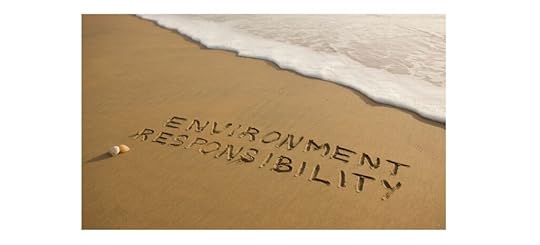
Travelling mindfully is perhaps about travelling long-haul but with a willingness to travel much more slowly and for longer periods of time. Having a green conscience. Looking at taking alternative methods of transport instead of flights where possible and finding ways to do some carbon offsetting when it’s not – like contributing a portion of your travel budget to a scheme planting trees.
Families are considering ‘ed-ventures’ for their children. Combining education with a holiday. It encompasses workcations – combining work and travel and technology – allowing for the opportunity for remote digital nomadic ways of working.
Mindful travel is about being discerning about your destination and your method of transportation…
It’s also about travelling sustainably. Having awareness and consideration for the environment and culture and the people in the place you are visiting and wanting to make a positive and responsible contribution to alleviate any poverty you might see or to help repair local ecosystems.
Part of this is the new Mindful Trend also incorporates Wellness Travel
The pandemic has caused us to be more aware of our emotional wellbeing and our mental health and travel trends are reflecting our need for open spaces and to connect with nature in the fresh air with hiking, wilderness tourism, wellness retreats, yoga and spa retreats. Even ‘Celestial Escapes’ that combine a sense of space with the opportunity for stargazing or watching the northern lights. ABTA reports a 28% shift in people that would normally choose to go to a beach destination choosing lakes and mountains and countryside instead.
Another travel trend emerging is for Bucket List Travel
Some are calling this Revenge Travel. A global survey by AMEX has shown that 60% of people asked – feel that after being stuck indoors for so long under lockdowns, they have missed out on travel opportunities and will want to catch up in future by travelling more and taking more time off in order to travel – taking their dream trips – but only when the pandemic is over.
I feel sure that this way of thinking is being led by those of us in our midlife and beyond – the empty-nesters – the retirees – who feel the sands of time running out and so we feel that we want to travel again before something else – like old age or health issues – gets in the way of us celebrating our big milestones and ticking off our bucket lists and achieving our personal travel goals.
And what about the struggling Travel Agents whom we sincerely hope will somehow survive the pandemic?
Well, ABTA is saying in their recent survey in Travel Weekly that they expect package holidays booked through travel agents to recover much quicker than flight only independent bookings. This is because people will want that extra security and flexibility and peace of mind that booking with a travel agent gives them.
ABTA’s research also shows that these reassurances afforded by a package holiday are becoming increasingly important to customers, with almost a quarter saying they booked for the financial protection, up from 19%, and almost one in five saying they wanted to be looked after in case something goes wrong.

How do you feel about travel right now or in the future?
Are you taking a staycation this year?
Are you eager to return to familiar destinations for future travel?
Or are you looking to complete a bucket list and take once in a life time trips?
Will you book with a travel agent or arrange your travel independently?
Do please get in touch. I’d love to hear from you!
You can email me through my Contact Me Page here on my website or get in touch through my social media channels. I’m on Facebook as The Backpacking Housewife and I’m on Instagram as Janice Horton Writer and if you are on Twitter please do Tweet to tell me about your travel plans @JaniceHorton in our New Future and in what is set to become a new and golden age of travel!
The post Travel Trends in the New Future of Travel! appeared first on The Backpacking Housewife.
May 3, 2021
10 Scary Travel Horror Situations And How To Avoid Them!
On the Backpacking Housewife website, I want to share with you all my travel stories. I want to tell you about the fabulous experiences I’ve had while travelling and exploring amazing destinations all over the world. I want to do this to inspire you to travel and to explore the world too.
BUT I wouldn’t be being entirely honest with you if I ignored the fact that sometimes, although thankfully rarely, accidents and the unexpected can happen and things do occasionally go wrong while travelling.
Sometimes things can get a little bit scary when you suddenly find yourself outside your comfort zone.
I’ve been asked if anything dangerous or scary had ever happened to me while travelling.
In recent media interviews, I’ve not only been asked about the wonderful and amazing experiences I’ve had while travelling, I’ve also been asked about travel safety and if I’ve ever personally felt unsafe while abroad.
My answer is yes. I have on occasion felt worried and unsafe or scared while travelling.
But it’s important to keep this all in perspective because I’m also aware that travel fear is something that keeps many people from reaching out and achieving their own dreams of living a life of travel and adventure.
So, in telling you about these scary travel horror stories that have happened to me, it’s certainly not my intention to put you off travel – the opposite in fact – I want to encourage you to recognise and to accept your fears, knowing that they are completely natural and normal and there is a lot you can actively do to keep yourself safe while travelling.
I’m living proof! I have travelled around the whole world twice – exploring 56 countries – over 7 nomadic years!
Because, in reality, travelling anywhere in the world shouldn’t be any more dangerous than travelling in your own country.
We all know that life itself is inherently dangerous.
And being afraid of travel is just the same as being afraid of the unknown.
Yet, the unknown is simply something – good or bad – that we haven’t experienced yet.
In the same way that a stranger could be a great friend whom we just haven’t met yet.
To stay safe we must keep our wits about us and learn to trust our own inbuilt intuition.
We should be sensible. Be aware. Be prepared. Be cautious.
And, importantly, we must learn to always trust our gut feelings.
While travelling, I personally like to take onboard astronaut and commander Chris Hadfield’s advice in his wonderful book ‘An Astronauts Guide To Life On Earth’.
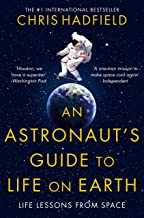 BUY ON AMAZON UK
BUY ON AMAZON UKBUY ON AMAZON US
In his book, Commander Hadfield shares all the life skills he learned as an astronaut training to travel further away from home than most of us are ever likely to travel in our own lifetimes.
Commander Hadfield says, that first imagining and then anticipating all the things that might possibly go wrong while travelling, and then planning in advance exactly what you might do to tackle the imagined and anticipated situation will allow you to release the fears and concerns you have about keeping safe.
So, in the spirit of anticipation and in being fully prepared, in the same way I have also shared a post about Mishaps and Misadventures While Travelling, I’m now going to share with you ten of my own real-life scary situations and how I dealt with them and ultimately – and very importantly – what I learned from the experience about staying safe.
And as a result, if you ever find yourself in the same scary situations, you might feel more prepared and less afraid to travel!
10 Scary Travel Horror Stories1: Finding ourselves in a notoriously dangerous part of town at midnight and during a blackout in Nassau, Bahamas. We’d been warned this part of Nassau was potentially dangerous at night.
We’d been warned this part of Nassau was potentially dangerous at night. We’d been in the Bahamas for a few weeks, renting an Airbnb at Cable Beach, just outside Nassau. One evening, my husband and I had travelled into town on a Jitney Bus to meet with a couple of new tourist friends we’d met earlier that day.
We’d arranged to meet for dinner and drinks at the famous Arawak Fish Fry area – a strip of beachside seafood restaurants and street food stalls offering local foods that are a famous tourist attraction.
We ended up staying out much longer than we’d intended. We were having fun and had found a bar with a nice vibe. When the bar closed, just around midnight, we were the last to leave.
We decided that we all share a taxi back up the road so we went out into the street to look for a taxi but found the street empty and quiet.
We’d all had quite a few drinks, but I suddenly felt quite sober on realising we might have put ourselves in a precarious situation. We’d been warned that this part of Nassau was a potentially dangerous place for tourists late at night.
And then, suddenly and unexpectedly, we were plunged into complete darkness.
There were no lights on anywhere and we soon realised this was a power cut situation. We just stood there in the dark not knowing what to do. There were no taxis on the street. There was nowhere open. The bar we’d been in was locked up.
We used our phones as torches but realised that we didn’t have any taxi numbers.
Then suddenly a big truck appeared out of the darkness and stopped right beside us. I was scared. The four of us were caught in its headlights and must have looked like frightened rabbits in a spotlight.
Luckily for us, the driver wasn’t about to rob us or kidnap or murder us. He simply wanted to offer his assistance. He saw we were tourists and he knew we shouldn’t have been there. He told us so – saying this wasn’t a good place for us to be so late at night – and he offered us a ride back to the area where we were staying.
Seeing he had lots of pots and pans and cooking paraphernalia in the back of his truck, and that he was obviously a street food vendor at the fish fry, we gratefully accepted.
As he dropped us off on the road where we were staying, his passing comment and instruction as we thanked him profusely for his kindness (and offered him some cash for his fuel and inconvenience that he refused to accept) was to suggest to us that if we ever saw him lost and in the wrong place in our country, that we would also stop to help him out.
Lesson learned: Take responsibility for your own safety but also know that not everyone is out to get you. There are good people everywhere in the world, and in my experience, the kindness of strangers is more widespread than you might expect.
2. Thinking we might be kidnapped in Central America. I knew something was wrong. I had goosebumps. My heart was racing.
I knew something was wrong. I had goosebumps. My heart was racing. We’d arrived in Central America late at night on a planned layover flight into a city with a notorious reputation for being potentially dangerous especially at night. I’d prearranged by email for our hotel to send out a car for us.
Top Travel Tip: if you are unfamiliar with the place you are arriving – particularly at night – and you’re not sure of the route to your hotel then do prearrange with your hotel to send out a car or taxi to meet you. Ask for the driver to hold up a card with your name on it to avoid you having to get into an unknown car at airport arrivals.
After arriving at our hotel and after checking in, we walked a short distance to a nearby fast-food restaurant for something to eat. It had been a long flight and we were hungry. Perhaps because it was quite late in the evening, the restaurant was empty. We paid for and ordered our food and sat in a booth with our drinks.
It was then that I happen to notice an old car pull into the car park and park directly in front of the window. The driver of the car looked right at me and for some reason I still can’t fully explain, I felt spooked.
The man came inside the restaurant. He glanced the menu and then deliberately looked our way once more. Once again, I happened to catch eye contact with him.
This time, I knew something was wrong. I had goosebumps. My heart was racing.
When the man went back to his car and I saw him still glancing our way and talking on his mobile phone, I took my hungry husband’s hand and I insisted that we were leaving immediately. We hurried back to our hotel and locked ourselves in our room. It’s not completely unheard of for tourists to get kidnapped and held for random in parts of Central America.
We’ll never know if the danger that I instinctively felt was real or imagined.
I’m glad we never had to find out.
Lesson learned: Trust your gut. If a situation feels wrong act immediately to protect yourself and feel safe.
3. Dealing with a drunk taxi driver in Asia. We could both smell alcohol. It seemed to be coming strongly from the driver.
We could both smell alcohol. It seemed to be coming strongly from the driver. We’d just flown into a big city in South East Asia that we’d visited many times before and so we felt confident about taking a registered airport taxi to our hotel. Only, after climbing into the back seat of the taxi, my husband and I both sniffed the air at the same time and looked at each other.
We could both smell alcohol. It seemed to be coming strongly from the driver.
This time it was my backpacking husband who acted instinctively.
He said “no, stop” to the driver and turning to me he said “okay, we are getting out.”
Lesson learned: Don’t feel embarrassed about asserting yourself and putting your safety first in a compromising situation. Trust yourself. If something doesn’t feel right… it probably isn’t.
4. Bus going off with our backpacks in Mexico.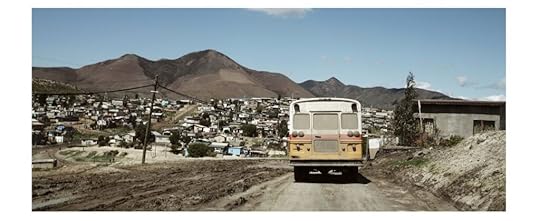 The bus continued on without allowing us to collect our backpacks
The bus continued on without allowing us to collect our backpacks This is a story that we laugh about now but when it happened it was quite stressful. We were backpacking in Mexico. Having flown into Cancun and travelled by public bus along the coast, spending some time in Playa del Carmen, heading over to the island of Cozumel on a ferry for a few days, then heading back to the mainland and continuing by bus onto Tulum set on seeing the famous Mayan ruins there.
When we identified the place that we were stopping just outside Tulum – and our hotel just across the street – we alerted the bus driver to stop the bus and let us off.
The problem was that as soon as we had stepped down off the bus, he continued on without allowing us to collect our backpacks, from the luggage compartment under the bus.
We watched him drive away in stunned silence for a moment then we saw another bus coming along the road. We ended up chasing the bus with our backpacks on it all across town on the second bus until we were able to retrieve our stuff!
Lesson learned: if the unexpected happens – don’t panic – look for a solution!
5. Tarantula in the bed in the Caribbean. We came home to find an enormous and hairy tarantula spider crawling on our bed.
We came home to find an enormous and hairy tarantula spider crawling on our bed. We’d been on a small island in the Caribbean for a week and rented a small house in a tropical garden. There were beautiful flowers and plants everywhere and trees laden with banana and cashews and coconuts – but unknown to us – this is a perfect habitat for the tarantula spider.
So, of course, not long after staying in the house we came home to find an enormous and hairy tarantula spider crawling on our bed. I will admit to you that my heart was pounding because back then I didn’t know if these types of spiders are poisonous or not. In fact, I’ve since learned they are not poisonous, but they are known to ‘fire their hairs’ at you as a defence mechanism, when they are afraid.
Feeling very afraid myself, I dashed next door to alert our landlady, who send her rather amused husband to extract the spider on our behalf while telling us that he ‘used to keep a tarantula spider as a pet when he was a child’.
In our bedroom, he approached the huge hairy beast with a broom onto which it dutifully crawled, before he put it back out into the garden.
Lesson learned: If you are faced with local wildlife try and find a local person willing to come and help you deal with it!
6. Scorpion in the shower in Honduras. I looked down to see a black scorpion showering with me.
I looked down to see a black scorpion showering with me.While in Honduras, Central America, I was horrified to be told by a new friend I’d met there how she had recently been hanging her washing outside when she’d been stung on the hand by a small black scorpion. She described the pain as horrific and ‘like being struck by a hammer’. Her hand was horribly swollen and she said she was still in a great deal of pain.
She also told me that luckily a local scorpion’s sting wasn’t fatal. Good to know.
But that still didn’t stop me from feeling absolutely terrified when, just a few days later, I was taking a shower and happened to look down to see a black scorpion showering with me and crawling over my foot!
I didn’t scream. I froze. I stood completely motionless waiting for the hammer of pain to hit me or the scorpion to climb off my foot. Luckily it moved away – and disappeared into a small crevice in the corner of the shower base.
Lesson learned: I knew I wasn’t in danger of death from a scorpion sting but I was in danger of experiencing extreme pain. I now feel it’s a good idea to acquire some knowledge of any dangerous local wildlife while travelling to tropical places so that you can assess the level of danger you might be facing.
We actually lived in that house for several months not really knowing where that scorpion actually went or if he would come back.
I learned to check for him every time I took a shower.
7. A venomous snake in the house! There’s a snake in the house!
There’s a snake in the house!While we were housesitting in a fabulous chateau in South West France we had an encounter with a very large venomous snake.
Inside the chateau, the rooms were huge and the stone walls so thick that in the summer when temperatures outside were at their hottest – we had 42 deg C – inside the house always remained refreshingly cool. This was probably why a large and very long snake decided to come inside and go to sleep behind a piece of furniture.
Having spotted the snake, we took a photo of it in order to identify it by its markings.
We discovered it was a viper – because it had slit-pupils rather than round pupils and from its distinct pattern and scales – and that it was highly venomous.
Not wanting to tackle it outside ourselves, while assuming there must be some kind of protocol in place for dealing with poisonous snakes in France, we went and sought the advice of our French neighbour.
We explained our situation and showed the photo on our phone.
He looked startled (both the snake and now our neighbour) and he confirmed that the snake was indeed very dangerous and he immediately armed himself with a broom (in the same way as our neighbour in the Caribbean had armed himself to catch the tarantula spider!)
But… worryingly… when we all returned to the house we discovered the snake was no longer behind the dresser and was in fact nowhere to be seen.
We’d left the door open so had it slithered away on its own accord?
Or, was there a hole somewhere in the stone walls of the chateau, that enabled it to enter and exit the room whenever it chose to come inside?
Lesson learned: We never did see the snake again. But, for the whole time that we lived at the chateau, I learned to be vigilant. I was always careful whenever I moved anything or cleaned the floors around the furniture anywhere in the house.
8. Dentist – root canal treatment in South Korea The Backpacking Housewife at The Happy Dentist in South Korea
The Backpacking Housewife at The Happy Dentist in South KoreaBefore the backpacking husband and I left Scotland, having sold everything we owned in order to travel the world, we had a checklist of preparations to travel.
One of the things on that list was to get a full dental check-up in order to pre-empt any future problems with our teeth while travelling.
So, I was both surprised and frustrated to find, just a few months into our travel itinerary and while on a small island in the Caribbean with no dentist, that I had developed a toothache.
The tooth ached mercilessly for weeks and all I could do was swill it with rum and take a paracetamol. Then, the pain seemed to settle down for a while, but started up again when we set off on our travels again.
We took a long flight to South Korea to visit our son and I think perhaps the plane’s cabin pressure started my toothache off again.
Thankfully, in South Korea, my son was able to arrange for me to see a dentist.
The dentist’s name when translated to English was ‘The Happy Dentist’ but I wasn’t happy after my consultation to be told that I’d need root canal treatment.
However, this did solve the problem of my excruciatingly painful toothache.
Lesson learned: Sometimes even when you try to pre-empt a situation you can’t avoid every possible scenario. What you can do is have a backup plan and that should certainly include having a travel insurance policy to cover any medical and dental emergencies while in another country. You might like to read a full post/article I’ve written about Travel Insurance options.
9. Getting a badly infected foot in Thailand.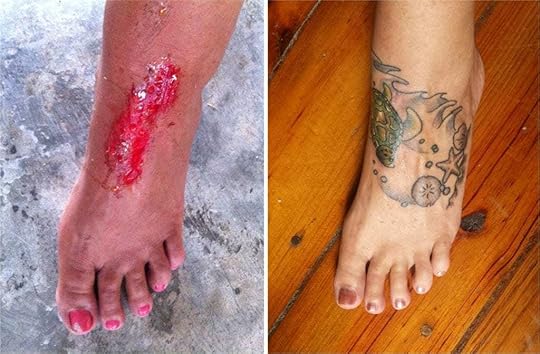 After cutting my foot badly in Thailand I eventually had a tattoo over the healed scar
After cutting my foot badly in Thailand I eventually had a tattoo over the healed scarHurting my foot in Thailand was actually an awful and extremely painful experience. My husband and I were walking down a steep pathway (ridiculously steep for a path, actually, but that’s Thailand for you!) and the path had dried in the sun after a heavy rainfall leaving a fine sand screed that I slipped on in my flip flops.
I went down so quickly that I believe if I hadn’t had my arm linked through my husband’s I would have probably broken a leg or something. Anyway, the damage seemed to be superficial at first, and just a sore scrape to the top of my foot.
Three days later however and the foot was obviously horribly infected.
I actually spared you the photos of this as the photo above was taken a few moments after I fell and before my foot got horribly infected.
I cleaned and dressed the wound as best I could but with the heat and humidity in Thailand, it is common for even a small abrasion to get infected.
I went to see a pharmacist and spent a small fortune on antiseptic cream and dressings but the foot soon got worse. It looked horrible. It was so painfully infected that I couldn’t even put it down on the ground never mind walk on it.
But I went back to the pharmacist, who seemed both surprised and concerned at seeing my foot in such a mess, and so cleaned it for me and prescribed a very strong course of antibiotics.
I can only describe the pain of having my infected foot cleaned as it being hit hard by hammers and slashed with glass both at the same time. It was excruciating.
The antibiotics started to work after a few days and the foot (eventually) healed. But I was left with a nasty reminder of what had happened to me with a scar on the top of my foot. A year later, I had the scar covered with a tattoo of a sea turtle in a coral garden, which I like much better.
Lesson learned: sometimes accidents happen no matter how careful you are. I was simply walking down a steep street after it had rained. I wasn’t drunk and I wasn’t being silly but I slipped and fell and hurt myself. It could have been worse. Again, it’s important that you have travel insurance to cover any medical costs while abroad.
If you are in your 50’s or 60’s or older it can be more expensive and difficult to get the right travel insurance for your needs so you might like to read a post I’ve written especially for you: Travel Planning – Travel Insurance For Over 50s.
10. Suffering Sandfly Bites Everywhere. The sun was shining as I lay there feeling strange tingles all over my skin
The sun was shining as I lay there feeling strange tingles all over my skin Many people prepare for their holidays in warm or tropical places by including an insect repellent in their packing essentials to deter mosquitoes from biting them.
But there is also another variety of biting and blood-sucking fly that can cause terrible skin welts and skin swellings that many people like to call ‘no see um’s’.
These are tiny sandflies that are so small that you cannot actually see them – only the damage they do to you – and unlike mosquitoes (who mostly prefer to attack at dusk) sandflies are fully active at all hours of the morning, noon, and night!
I was blissfully unaware of the existence of sandflies when I took myself down to the beach to lay on my towel and sunbathe one afternoon while on a beautiful island in the Caribbean.
The sun was shining. Palm trees swayed. The sea was blue and crystal clear as waves lapped the shoreline of the pristine white sand beach as I lay there feeling strange tingles all over my skin.
I applied my sunscreen thinking I was getting ‘prickly heat’ and carried on trying to enjoy my afternoon. Eventually, unbearably uncomfortable with my skin feeling itchy, I went for a swim and then feeling restored I went back to the beach, picked up my towel, and headed for home.
Home was the beautiful Caribbean style beach hut we’d just rented for our stay and where my husband was when he saw me and suddenly cursed out loud like a pirate.
I was unknowingly at that moment absolutely covered in tiny red sandfly bites.
There was hardly a space between any of them but the ones on my back were worse from where I’d been lying on my towel on the sand. My husband took a photo of my back so he could show me what it looked like and I was horrified.
A few hours later and the tiny red welts grew bigger and were so itchy and looked so awful that I was driven quite mad. My only relief at that time was an antihistamine ointment that we’d sensibly brought with us to the island in our emergency travel kit.
Lesson learned: Sandflies are common all over the Caribbean and in many tropical places. I learned how to best deal with sandfly bites from talking to local people who helpfully told me what I could to use to treat the bites and to help prevent the sandflies attacking and biting me.
I was also told that after spending about three months on the island, a person’s natural immunity would usually kick in, meaning that the skin would not then react as badly to the sand fly bites.
I assume that’s why the local people around me didn’t appear to be suffering from sandfly bites or to be covered in the distinctive red welts.
I have written a post on all the tips I learned about dealing with sandflies and treating sandfly bites especially for you: Suffering SandFlies – the dreaded no see um’s. It’s one of the most visited articles on this website!
I do hope this post on scary travel horror stories has entertained and informed you and not put you off travelling.
If I’m not put off by all of this then neither should you be because:
There is so much in this wonderful world to see and experience.
There are far more good people in the world than bad people.
The kindness of strangers is more widespread than might think.
So… don’t be put off by what may or might not ever happen.
 Don’t be put off travelling by what may or might not ever happen.
Don’t be put off travelling by what may or might not ever happen.
Instead, prepare yourself for anything by taking a leaf out of Commander Hadfield’s wonderful book ‘An Astronaut’s Guide To Life On Earth’ BUY UK or BUY US and equip yourself with the knowledge and tools to overcome any fears you may have troubling you or any reticence you might have in the back of your mind about travelling near or far.
If you are over 50 years old you might like to read my post: 10 Reasons To Travel In Your 50’s and 60’s
And bravely go after your dreams of travel and adventure!
Share the Love with a Repost Tweet and Pin!The post 10 Scary Travel Horror Situations And How To Avoid Them! appeared first on The Backpacking Housewife.
April 26, 2021
Backpack or Suitcase for Older Travellers?
So you’re finally planning a trip! Where are you going? On holiday? A well-earned vacation?
Where are you staying? Hotel? Cruise ship? Villa? Apartment? Hostel?
Will you be staying in just one place or is this going to be a multi-destination trip?
How long will you be away? A weekend or a week or two… or perhaps longer?
And… will you be taking a suitcase on your travels or packing a backpack?
To help you decide between the dilemma of packing a suitcase or taking a backpack, I want to share with you my own considerable and sometimes painful experiences of battling with baggage as a (slightly) older person while travelling.
Indeed, having travelled around the world twice, first with a suitcase and then with a backpack – while in my late 50’s / early 60’s – I now feel qualified to offer you my honest and tried and tested recommendations, so that you won’t ever have to suffer the burden, the expense, and the consequences of choosing and travelling with the wrong type of luggage!

Looking back to when we travelled as a family, taking our two-week annual holiday, we’ve always favoured soft-sided suitcases without wheels. I recall my husband and I had one big suitcase each and we had one extra large-sized one for the kid’s stuff (we have three sons) and we usually bought our luggage cheaply from a discount store. Consequently, it never lasted from one year to the next.
Of course, we’d each have a carry-on bag too for our essential in-flight accessories.
To be honest, travelling with three kids in tow and usually flying off somewhere, we always had way more baggage allowance than we ever needed and so I never even thought to pack light.
Although, I do remember that it always took some effort to manhandle our luggage into our people carrier and from the car park across to the airport, where we’d have to commandeer a wayward luggage cart – usually one with wonky wheels – to get to the check-in where we could happily rid ourselves of our luggage burden knowing the next time we’d see all our carefully packed stuff (hopefully) would be at our final destination.
Our destinations of choice back then were either budget flights to the Canary Islands or package tours the USA – the kids loved beaches and theme parks – and whatever kept the kids happy made us as parents very happy too.
Fast forward ten plus years. The kids are off doing their own thing. We are empty nesters.
We are empty-nesters who (this was seven years ago) at 54 years old decided to sell everything we owned – house, cars, furniture… everything – so that we could boldly travel the world as adventurous nomads on what would hopefully be a long-term basis.
At this point – realising everything we now owed would be transported around the world with us – I decided to rethink how we would carry our luggage and I decided that this time we would need two good quality and extra-tough suitcases that would last us over many years of world travel.
I decided that this time we would need two good quality and extra-tough suitcases that would last us over many years of world travel.
I did my research online and soon found a travel website putting ten different branded suitcases through their paces. I was delighted to see this meant dragging them industrially about at an airport. Then bashing them around on luggage conveyor belts and even throwing them from a great height off a plane and onto a concrete runway to see if they’d burst open!
Impressed, I invested in two of those declared the outright winner.
I bought two large-size and hard-sided stylish suitcase with wheels by a manufacturer called Delsey.
I also bought two quality cabin sized suitcases and treated myself to a flight-size handbag.
At the same time, I invested in lots of discreet and travel-savvy accessories, including crossbody wallets to keep our passports and our cash and credit cards safely on our persons while we travelled.
Travelling with Suitcases Ready to fly and to tackle airports all over the world with our super strong suitcases
Ready to fly and to tackle airports all over the world with our super strong suitcasesFully equipped and fully packed to the exact weight restrictions for the economy flights we’d booked, we travelled west over the Atlantic to explore the USA, the Caribbean and parts of Central America. Then, we headed across the Pacific to visit our son who lives in South Korea, all with our wardrobe sized suitcases now plastered in souvenir destination stickers.
But to be honest, even on their super sturdy wheels, it still felt like really hard work to manoeuvre our large size suitcases when we were travelling so frequently from one destination to another.
And, the effort required in getting them onto busses or hauling them in and out of taxis – or tuk-tuks – was getting all too much and we were starting to feel heavily burdened with our baggage.
After visiting South Korea, our plan was to complete our trip around the world by returning home to the UK to see family and friends for a couple of weeks, while we finalised plans for our next trip. This meant getting some more travel vaccines and acquiring the necessary travel visas for several months of travel in Thailand, Malaysia, and the Philippines.
This return also gave us the opportunity to rethink our suitcase situation.
We’d both come to realise that to travel more easily through Asia – travel that would certainly involve taking many flights, buses, and then various types of boats to our planned destinations, where we’d be expected to carry or drag our own luggage across beaches or along dirt tracks or through jungle terrain – we were going to have to travel lighter and with much more flexibility.
I suggested abandoning our suitcases and acquiring backpacks.
But we weren’t entirely sure if they would be up to the job of carrying all our stuff.
Or convinced that WE would be up to carrying all our stuff on our backs.
We were in our mid-50’s after all and my husband travelled with lots of scuba diving gear.
Travelling with BackpacksWith all the enthusiasm of my previous research, I investigated the ‘best backpacks’ for long-term travel and soon settled on some very attractive looking Highlander Outdoor backpacks.
I chose them primarily because I liked the choice of colours and because they had an accessible all-round zip opening – suitcase-style – rather than the single top loading style of a typical trekking backpack. The Highlander backpack also came in different sizes. A larger (black) one for my Backpacking husband and a slightly smaller (pink) one for me.
I also favoured them for being Scottish – as we are proudly Scottish ourselves.
The Highlander backpacks had padded straps for shoulder comfort and a useful attachable/detachable matching daybag too that would replace our current cabin bag suitcases. The backpacks looked to be made of good quality tough-looking canvass type of fabric (with optional pull on waterproof covers) and with a zip-out expandable panel section for extra room. They looked to be good quality and they looked to be durable.
With our new backpacks bought, packed, and fully expanded, we carried them proudly on our backs and we carried our daybags attached to our fronts. Looking like real backpackers, we set off from Edinburgh to Bangkok, from where we’d planned to travel across Thailand and then island hop down the Andaman Sea until we reached Malaysia.
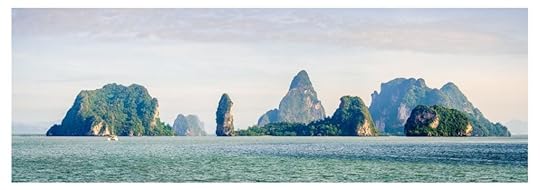 Our plan was to travel by boat and island hop all the way down the Andaman Sea to Malaysia
Our plan was to travel by boat and island hop all the way down the Andaman Sea to Malaysia It was a dream trip. It turned out to be one of the best and most memorable in all our travels. But our backpacks proved to be far too heavy for us and our poor middle-aged spines soon began to suffer. It was no fault of the backpacks of course. They just didn’t suit us, all our gear, or our poor old backs.
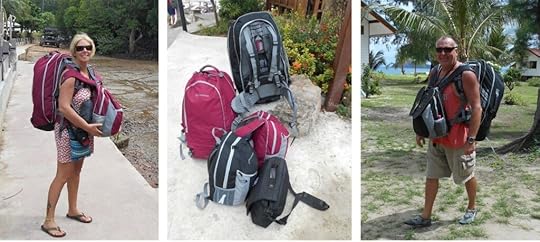 I loved travelling with our Highlander backpacks and daypacks but they proved too heavy with all our gear
I loved travelling with our Highlander backpacks and daypacks but they proved too heavy with all our gearI struggled so much to carry my backpack that sometimes my poor backpacking husband had to carry mine too. His backpack took all his scuba diving gear but that didn’t really allow room for many clothes. So he tended to carry his clothes in his day bag. I’m sure wearing our backpacks we looked like travelling giant tortoises with our homes on our backs.
 I’m sure with our huge backpacks we looked like giant tortoises with our homes on our backs!
I’m sure with our huge backpacks we looked like giant tortoises with our homes on our backs!I realised I’d made two expensive mistakes. The first was in buying the large super-sturdy but unyielding suitcases.
Then, secondly, in thinking that we could actually carry everything we owned in backpacks on our backs.
Although, I’m sure that would have been perfectly okay for much younger backpackers than ourselves.
It was clear we were going to have to find a more comfortable and adaptable and much lighter way to travel that suited us as older travellers in future.
Travelling with Wheeled Rolling BackpacksFor us, the solution was to get travel bags with wheels and also straps that tucked away but were fully accessible for all those occasions when you want your rolling travel bag to also be a backpack.
Because sometimes you need to keep your hands free for climbing out of longtail boats into knee-deep water and while having to walk the entire length of a sandy beach to find your accommodation.
The backpacks/travel bags we chose were soft and waterproof and also had a strong retractable handle to pull out when we needed wheels for easily hurrying along the smooth floors in hotels and airports or city pavements and sidewalks.
In a wheeled ‘rolling’ backpack we knew we’d found the best of both worlds!
 Travelling by longtail boat along the Andaman Sea. Photos: Janice Horton
Travelling by longtail boat along the Andaman Sea. Photos: Janice HortonSo, dear travellers, after travelling for seven years and having explored 56 countries while circumnavigating the whole world twice with our luggage… this middle-aged backpacking housewife and her scuba diver of a backpacking husband… heartily and absolutely recommend to you a ‘rolling’ backpack with wheels!
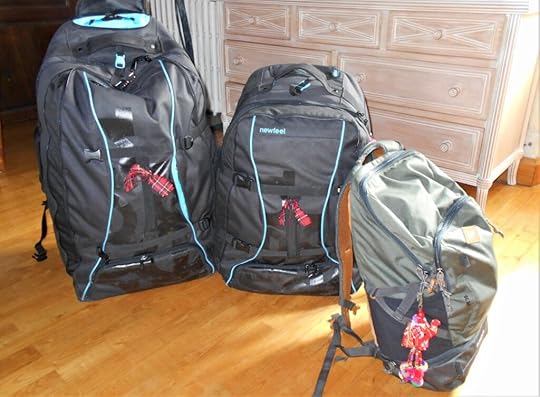 Fully packed! His and hers lightweight backpacks with pull out handles and wheels. Plus my daybag on the right.What To Look For In A Rolling Backpack
Fully packed! His and hers lightweight backpacks with pull out handles and wheels. Plus my daybag on the right.What To Look For In A Rolling BackpackMaterials: We found that sturdy and high quality not only added to the price but also meant heavy when it came to luggage. In a wheeled backpack, you should perhaps look for a compromise in weight and quality for the fabric, the zippers, the pull handle, the frame, and the wheels. Is it waterproof or water-resistant? Is it robust and tearproof?
Comfort: Do the wheels glide? Is the handle the correct height for you? You should check if the stowaway harness and shoulder straps are padded and a comfortable fit. What about the back panel? Often, roller backpacks don’t offer as much padding for spine protection or back ventilation as regular backpacks.
Size: Consider what you need to carry with you when you travel so that you can choose the correctly sized dimensions for your purposes and for your travel arrangements. As I said, my husband needed a bigger size backpack than me because he has lots of professional dive gear. Backpacks sizes are offered Litres. Smaller backpacks are around 35L. So 45-55L would be medium-sized and suited for most purposes. 60-70L is a large-sized. Extra-large is anything over that and some packs are available in 110L and 130L sizes. The larger the backpack the heavier it is of course.
Storage: How easy is it to pack and organise? Is everything accessible or are you going to have to unpack everything again just to find a scarf or your sunscreen? Are there handy internal and external compartments? Are the external ones secure?
Where To Find The Best In Rolling Backpacks My%20StoreFront" target="_blank" rel="noopener"> My%20StoreFront" target="_blank" rel="noreferrer noopener">Click To Visit The Backpacking Housewife Shop on Amazon to Browse Travel Essentials
My%20StoreFront" target="_blank" rel="noreferrer noopener">Click To Visit The Backpacking Housewife Shop on Amazon to Browse Travel Essentials
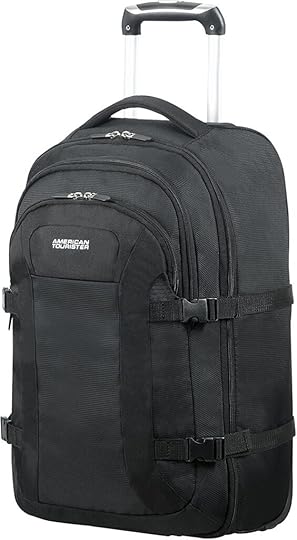
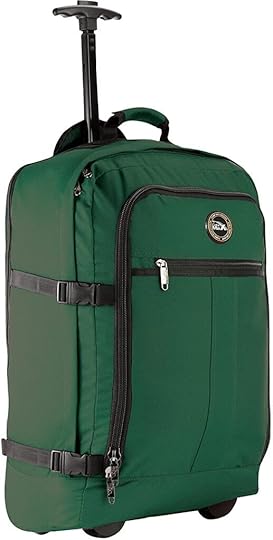

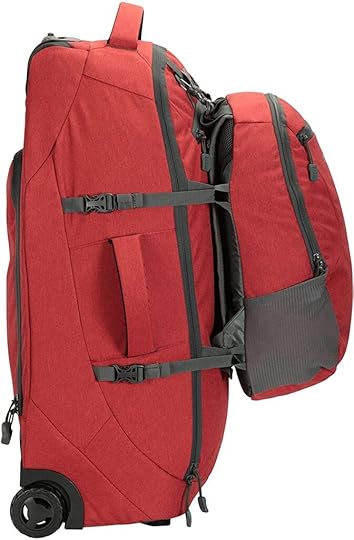


 My%20StoreFront" target="_blank" rel="noreferrer noopener">Click Here To Browse Wheeled Rolling Backpacks on Amazon
My%20StoreFront" target="_blank" rel="noreferrer noopener">Click Here To Browse Wheeled Rolling Backpacks on Amazon 
Are you a suitcase or a rolling luggage fan?
Have I convinced you to be a backpacker yet?
Do let me know your backpacking luggage stories!
Share the Love with a Repost Tweet and Pin!The post Backpack or Suitcase for Older Travellers? appeared first on The Backpacking Housewife.
April 20, 2021
10 Reasons To Travel In Your 50s And 60s
If you needed encouragement to travel more in your 50’s and 60’s then you might be emboldened to know that senior travel is to become a post-pandemic trend with travel agents now promoting ‘Age-Friendly Tourism’ as more older people than ever before are looking to prioritise travel in their lives.
It’s being reported in The Times that the proportion of people planning to retire early has more than doubled since the coronavirus pandemic.
But it’s not just those looking to take early retirement or finally reaching retirement age who are fuelling their own fresh opportunities for adventure or boosting their own appetites for travel – it’s all being led by a whole generation of ‘boomers‘ who are longing for a well-earned lifestyle change.
Whether it’s the new phenomenon of ‘revenge travel’ in the wake of the Corona Virus pandemic, or the desire to live life more freely on our own terms after the restrictions of lockdown, we are being told that travel will be ‘all the rage’ in the new future and experts are expecting a boom in boomer travel.
I’m an enthusiast of travel at any age but I want to share with you why I personally believe it’s best to travel in your 50’s and 60’s and how travel experiences in your midlife can be even more rewarding and beneficial than in your younger years and that one day… hopefully soon… we will all be able to travel again.
And all that makes RIGHT NOW the PERFECT TIME to DREAM and PLAN for TRAVEL in the NEW FUTURE.
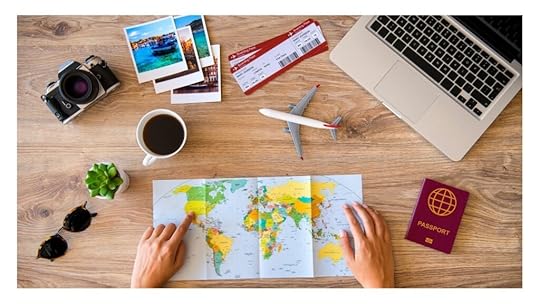 World travel is no longer just for the younger generations.
World travel is no longer just for the younger generations.I’m not saying that travel isn’t a privilege – it definitely is and it always will be – but it can be perhaps more accessible and probably more affordable than you might expect to travel in your midlife ‘golden’ years.
I want to show you through reassurance and by example how travelling is done in your 50s and 60 or even older throughout this website and if you are a little unsure… or scared and even a little bit afraid… then it’s okay. It’s only natural to have travel fears, particularly when we are older, but you should ask yourself if those fears are realistic or just an excuse?
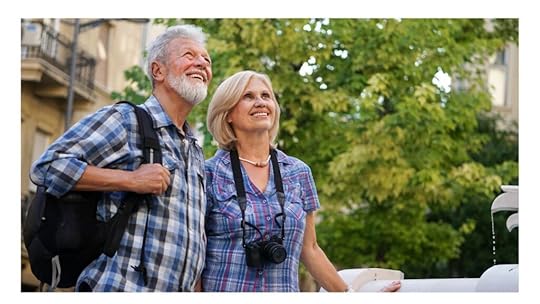 World travel is no longer just for the younger generationsTravel Fear in your 50’s and 60’s is natural but is it just an excuse?
World travel is no longer just for the younger generationsTravel Fear in your 50’s and 60’s is natural but is it just an excuse?Understandably, most older travellers worry about health and safety and money, and it’s true that travel can be dangerous. The news media reminds us of this danger constantly and now we have the Corona Virus pandemic making us wary of others and even more worried about travel. But let’s look at the Fear Factor in a little more detail.
There actually is a list of The Most Dangerous Places in The World but there is also a list of The Most Beautiful Places in the World that we should all hope to see with our own eyes. Stranger danger too is a real threat and we are constantly reminded that there are Bad People lurking ‘out there’ waiting to trick and rob and hurt and even kill us. Unfortunately, that might be true at home as well as abroad.
It’s also true, certainly in my own experience, that there are many more good people in the world than there are bad.
And, all over the world, people just want the same things: decent food… clean water… a roof over our heads and a safe place to sleep. Health and happiness for ourselves and our loved ones.
We can counter The Fear by being brave and sensible, being prepared, being equipped, taking precautions, and weighing up the risks in knowing that life itself is a risk wherever we are in the world.
So why not grab your chance to be Bold Not Old and embrace your Golden Years of Travel!
 Travel Trends in those Aged Over 50
Travel Trends in those Aged Over 50A new Travel Trends Survey has discovered that more than half of those aged over 50 plan to travel in 2021 and are actively selecting destinations, booking accommodations, and scrutinizing COVID-19 safety protocols and how accommodation and transportation providers are responding to safety concerns.
More than a third of those over 50 years old are likely to have a ‘Bucket List’ of things they want to do before they die and according to an article in The Scotsman newspaper: “Having worked hard, many believe 50 is the point where their life is just getting started. In other research, we discovered that eight out of ten people age 55 and over will use assets such as property wealth to live a fulfilling and enjoyable retirement, with one in four admitting they would invest in a holiday of a lifetime.”
Bucket list holidays will be particularly popular with the older generation, suggests Travel Up Website: “Those with a good amount of disposable income are researching bucket list holidays like never before.”
 More than a third of those over 50 years old are likely to have a Bucket List
More than a third of those over 50 years old are likely to have a Bucket ListThe over-50s travel market is “more adventurous, diverse and lucrative than many imagine” says Selling Travel who claims long haul destinations and luxury travel is important to this age group. Those in their 50’s are also more likely to take grown-up gap years to do their bucket list or take work sabbaticals in order to prioritise slow travel in their lives.
With their children grown up and leading independent lives, parents in their 50’s are now just as likely as those in their 20’s to embrace a more flexible location free working environment in order to mix travel with ‘workcations’ and opportunities to work remotely as ‘digital nomads’.
Many are also looking to travel more sustainably and mindfully in future and plan to take Work Away breaks or to volunteer on conservation or charity projects to make travel meaningful.
“Our survey of British over 55’s sought to prove that a sense of adventure doesn’t diminish with age,” says Woman and Home magazine. And, so it has proved. Not only do a majority of over 55s have a travel list but they can see that now is the best time to complete it.
Couples Travel: Solo Travel: Group Travel in Over 55’s“Free from the burdens of a young family and not limited by financial or work-related constraints, people actually find more freedom to explore in older age than when they are young.”
Woman and Home Magazine
The survey also revealed that most over 55’s want to travel as a couple or with a friend or to travel with a group but a solid 10% of them prefer to go it alone to complete their bucket list.
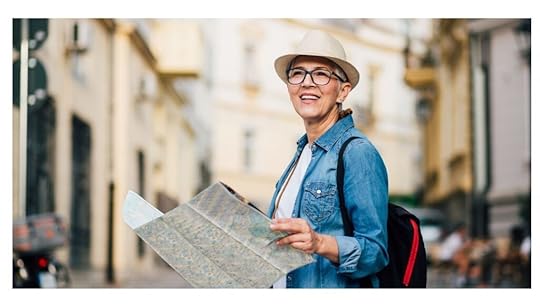 Travel in your 50’s and 60’s is possibly the very best age to travel!
Travel in your 50’s and 60’s is possibly the very best age to travel! A European survey (2020/21) found that people between the ages of 60 and 74 wanted to travel more intensively while they had reasonable health and because of the available time following retirement. On the other hand, people over 75 tended to travel less (in relation to their share of the population) possibly due to a decreasing motivation to travel or to health issues.
All proving that travel in your 50’s and 60’s is possibly the very best age to travel!
Perhaps you’ve spent years working a job and waiting for the freedom of the weekend?
And spent years fitting your travel and adventure into an annual two-week holiday slot?
Personally, I spent all of my 20’s working on building my career. I spent my 30’s making a home and having children and also working. I spent my 40’s raising teens and encouraging them to become well educated and well-rounded adults.
During these wonderful decades I longed to travel and we often did – saving up for family holidays in far flung places – and raising our kids to think of themselves as citizens of the world rather than just one country.
Then, in our mid-50’s, once our kids had left home and had left us with an empty nest, my husband and I decided we no longer needed a home – we just needed a phone – and the resources to travel.
We didn’t have much in the way of cash savings but we did have a house and furniture and cars.
So it came down to a simple choice of staying home or travelling around the world.
 The Backpacking Housewife and Husband at The Grand Canyon
The Backpacking Housewife and Husband at The Grand CanyonWe also had a couple of small private pensions we could take early and we knew from life experience so far that at 54 (the age we were then) we still had the ways and means and capacity to earn some money to support ourselves.
I had my writing and my practical husband could turn his hand to most things.
Although, what he actually ended up doing during our first years travelling, was making his personal dream come true by training and qualifying as a scuba diving instructor.
During the same time, a personal dream come true for me too, when I wrote my Backpacking Housewife series of books to be published by HarperCollins.
Living a life of travel and exploring the world in our prime or golden years has afforded us opportunities we would never have believed possible!
 10 REASONS TO TRAVEL IN YOUR 50S AND 60S
10 REASONS TO TRAVEL IN YOUR 50S AND 60S1. You’ll get to live life with no regrets. When you are older, you get to realise that time is more important than money. But, unless you are fortunate to have savings or a big pension pot, affording your dream of travelling the world in midlife could come down to making a few different lifestyle choices or shifting your priorities. We decided to sell everything we owned to afford long term travel when we were in our mid-50’s and we have no regrets. I’m not saying that everyone should be spending the kids inheritance like us but I am suggesting that you shouldn’t let the idea of leaving money or assets for your loved ones after your death stop you from living your dream of travelling in your later years.
2. You can practice adventure before dementia! Experiencing new places, cultures, languages, and people, have all been proven by scientists to improve cognitive function – it’s good for your older brain – so travelling in midlife can keep your brain healthy and keep your mind more alert for longer than if you’d stayed at home.
3. A grown-up gap year will make you see the world differently and from a new perspective. Time spent travelling broadens the mind and expands both horizons and tolerance. It can make you perceive everything differently and realise that there is still so much to learn about the world.
4. Travel can give you a new purpose in life. Why not make a difference and volunteer on conservation or charitable ventures abroad? There are lots of fabulous organisations all over the world that encourage those over 50 and in retirement to find and volunteer on the perfect project for them. Organisations like Volunteer World, Work Away, Global Vision International (GVI). Projects Abroad and Volunteer Forever are just a few. Please be sure to do your own comprehensive and full research into any volunteering opportunities and organisation.
5. Travelling in midlife can be tiring so why not take it slowly? Spending several weeks or even months at a time in a place can prevent jetlag and reduce your travelling carbon footprint. Slow Travel can also help you to truly experience living like a local and give you the chance to make new lifelong friends.
6. Frugal or fabulous? The choice is yours. If being older and more mature means you are more decerning and you now appreciate your comforts then leave the hostels and hard bunks to others and choose to stay in good quality and comfortable accommodation. Travelling – even backpacking – can be done in comfort and even on a budget is way more affordable in some countries than in others. You just have to learn your travel hacks and ways to be fabulously travel savvy.
7. You learn to trust your gut in all situations. You have the benefit of maturity and wisdom and life experience and so have learned to stay safe and sensible by listening to your gut and trusting your own instincts.
8. Choose to plan or not to plan: Make your plans and live your dreams but don’t forget to leave room for spontaneity and to allow for impulse trips and to take advantage of unexpected opportunities that might come your way. In my experience, that kind of thing happens all the time when travelling.
9. Have fun creating and ticking off your bucket list! Makea list of all the places you’ve dreamed of seeing with your own eyes but don’t forget to include experiences to live and feelings to feel.
10. Write about it! You can inspire others to be bold and travel in their 50’s and 60’s by keeping a journal of your travels or create an online blog to share your adventures with friends and family back home. If only so they have an idea of not how you are but where you are!
Are you planning to travel more in your 50’s and 60’s?
Are you joining the post-pandemic trend of travelling in your golden years?
Are you considering ‘revenge’ travel after life in lockdown?
Do you have a bucket list?
Do you have Travel Fears?
Don’t hesitate to leave a comment as I’d love to hear from you!
Share the Love with a Repost Tweet and Pin!The post 10 Reasons To Travel In Your 50s And 60s appeared first on The Backpacking Housewife.
April 7, 2021
Packing List For Scotland
Under normal circumstances, every year millions of visitors from all over the world flock to Scotland. Tourists come to Scotland enjoy the natural beauty and the breath-taking and dramatic Scottish landscapes, the centuries-old history, the ancient heritage and, of course, to experience the amazing food and the drink that is inherently part of Scottish culture.
What to pack and what to wear in Scotland? Yet, many of those visitors who come to experience all that Scotland has to offer must wonder what exactly they should pack in their suitcase or backpacks for a destination where outdoor activities might include shopping and sightseeing but also wild camping and wandering around castles, hiking through heather and glens and trekking around lochs, climbing mountains and bagging monroes – when the weather is so notoriously unpredictable!
IMPORTANT: Please check Scottish Government Guidance before travelling.
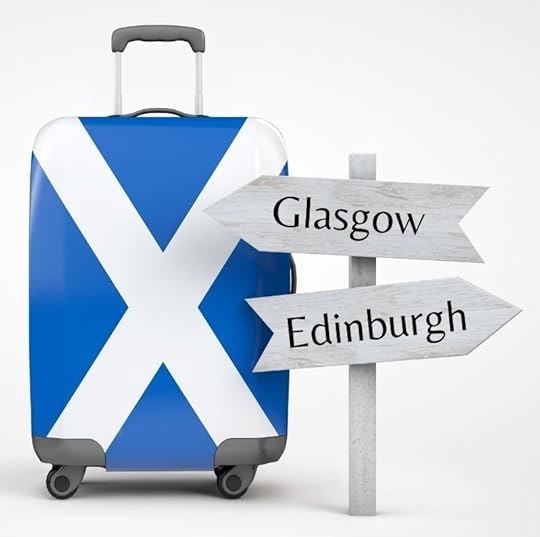 QUOTES ABOUT THE WEATHER IN SCOTLAND
QUOTES ABOUT THE WEATHER IN SCOTLAND“In Scotland, there is no such thing as bad weather, only the wrong clothes.” Billy Connelly
“If you don’t like the Scottish weather, wait 30 minutes, and it’s likely to change.” Raymond Bonner
“Today’s rain is tomorrows whisky!” Scottish Proverb
“It’s fine weather we’re having. The rain is falling straight down and kind of to the side.…” William Wallace (In Braveheart)
“In Scotland, beautiful as it is, it was always raining. Even when it wasn’t raining, it was about to rain, or had just rained.” Colin Hay. Actor
“I love summer in Scotland. It’s my favourite day of the year.” Unknown
“There are two seasons in Scotland: June and winter.” Billy Connelly
TO EXPLAIN THE WEATHER IN SCOTLAND
Scotland is usually wetter and cooler than England because of the hilly terrain and the low-pressure systems coming in from the North Atlantic current. The prevailing winds are generally from the west and southwest.
The high latitude of Scotland means that in the winter the days are very short and in summer the opposite is true and the days are very long. On the longest day (21st June) there’s no complete darkness in the northerly parts of Scotland.
Many Scots will promise you that you’ll experience “all four seasons in one day.”
January and February are the coldest months in Scotland with snow falling on high ground. July and August are normally the warmest months but don’t get too excited because temperatures are an average of 19 degrees Celsius.
The rainfall in Scotland varies extensively from an average of 3000mm per year in the western Highlands to under 800mm per year near the east coast. The wettest parts of Scotland will experience an average of 250 days of rain per year, whereas the driest parts only experience an average of about 150 days of rain per year.
Did you know there are over 100 words for weather in Scotland?!These include my favourites: Dreich. Dour. Pure Baltic. Snell. Flaggie. Hailing Bullet Stanes. Droolkit. Haar. Oorlich. Stoatin’. Smirr. Gloaming.
WHEN IS THE BEST TIME TO VISIT SCOTLAND?In my experience, having lived in Scotland for most of my adult life, I would certainly recommend Springtime (April and May) or Autumn (September and October) to you as a ‘best time’ to visit Scotland.
Springtime in Scotland is often still cold (average temps 7 – 13 deg C) and there is still the threat of snow on the hills. Right now, I’m in Scotland while writing this post and its April. Yesterday I was out walking in the cold but dry bright Scottish sunshine.
Today it is snowing heavily and that snow is coming down sideways in the wind.
But, not to worry, as I’m cosy indoors and have a log fire roaring in the grate and this afternoon could well be dry and bright and sunny again!
“N’er cast a clout until May is oot…” are wise words which means don’t ever take off any layers of winter clothing until the end of May!
But in springtime, with the one-hour switch over to British Summer Time, the days do feel longer and the weather can be brighter. In my experience, it can often be drier in springtime than in the summertime when Scottish skies can be heavy and leaden grey.
In summertime, if the weather is dreich (damp and grey) then you’ll also have to be prepared to deal with the dreaded ‘wee beasties’ or infamous Scottish midge – the biting flies that plague both locals and tourists alike from late May to late September.
There are over 35 different species of biting midge in Scotland and generally, the more northerly you go, then the worse the midge problem and the more ferocious the biting midge. For the unprepared, visiting the Scottish Highlands in Summer can be torturous. You have been warned!
The Midge ForecastVisitors to Scotland during the summer months can check the Scottish Midge Forecast – yes, there really is such a thing – which will tell you how severe midges are likely to be on a given day in a particular location and offer advice on how to thwart the wee biting beasties.
I have also written a post on how to prevent biting flies such as midges, sandflies – the no see ‘ums – and mosquitoes etc from spoiling your holiday you that might find helpful.
Autumn in Scotland, like springtime in Scotland, is a ‘shoulder season’ that can often offer spells of drier weather and milder temperatures (average 8 – 14 deg C) together with off-peak accommodation costs and fewer crowds than in the summertime in the most popular tourist spots in Scotland – like taking a tour of Edinburgh Castle.
Of course, many people want to come to Scotland in the summer months (average temps 15 – 17 deg C but of course it can sometimes be much warmer) because that’s when the wonderful Edinburgh Festivals will normally take place.
August is when the Edinburgh Fringe and Edinburgh International Festival and The Edinburgh Military Tattoo at Edinburgh Castle happens.
There are actually eleven festivals hosted in Edinburgh each year, the ones I’ve already mentioned plus the Edinburgh Science Festival, Edinburgh International Children’s Festival, Edinburgh International Film Festival, Edinburgh Jazz & Blues Festival, Edinburgh Art Festival, Edinburgh International Book Festival, Edinburgh International Storytelling Festival and lastly, Edinburgh’s Hogmanay.
WHAT TO PACK FOR SCOTLAND IN ALL SEASONS?So… with all these activities on throughout the year and in all seasons… what do you wear and what do you pack for a holiday in Scotland?

My recommendation for all seasons in Scotland is layers of clothes. Vest tops. Long-sleeved tops. Short-sleeved tops. A cotton shirt. A woollen sweater. Leggings. Jeans. Quick-dry cotton trousers are a good idea and also waterproof trousers for when the weather is oorlich (damp and freezing). You’ll definitely need a raincoat so that you don’t get droolkit (soaked to the bone) and you might want to keep your phone in a waterproof phone case. A warm hat is a good idea but don’t buy one of those awful tacky tartan tourist ‘Jimmy’ hats with nylon red hair attached to it. You’ll also need good comfortable waterproof trainers and/or shoes or boots.
But don’t stress. If you own any of the items mentioned already then why not bring them with you in your luggage and then buy all the other things – like warm woollen sweaters – when you arrive in Scotland?
Scotland is famous for its traditional wool and luxury cashmere knitwear using Arran and Hebridean Wool, Harris Tweed, and Tartan and Fair Isle patterns, to name a few.
On Your Packing List For Scotland… you’ll also need:TRAVEL INSURANCE
Click HERE Read my Blog Post about Travel Insurance
 WHAT TO PACK FOR SCOTLAND IN SPRING
WHAT TO PACK FOR SCOTLAND IN SPRING(March: April: May)

Springtime in Scotland is often bright and breezy. It can also be wet and windy which can make it feel icy cold (pure Baltic) both in the city streets or the open countryside.
So, wear layers of clothing and lightweight woollies under your rain jacket and insulate against the biting winds with a warm scarf and hat and gloves and use a wind-resistant umbrella. Carry all your stuff around in a waterproof daypack.
Wearing (waterproof) boots and woolly tights/leggings and thermal underwear is also recommended if you are planning to be outdoors a lot or exploring high ground.
For hiking or even looking around castles, lightweight waterproof over-trousers on top of your leggings or jeans and a fleecy sweatshirt or a woollen sweater and a padded body warmer are all ideal as outerwear and also casual attire too.
In springtime, several warm but lighter layers are better than one big heavy sweater, so that you can layer up and adjust as necessary between the sunny spells and rain showers.
WHAT TO PACK FOR SCOTLAND IN SUMMER(June: July: August)

Again, lightweight layers should be the main items on your Scotland In Summer packing list. Scotland in summer can be warm and sunny and dry on one day and everyone will be out wearing sunglasses and shorts and t-shirts. And then the next day, you might need your jeans/trousers and a cardigan/sweater and carry a rain jacket again.
If the forecast is dry, then late summer evenings in Scotland can still be chilly, so be prepared and wear or carry a long-sleeved fleecy top. Carry your wind-resistant umbrella just in case it rains in your day bag and don’t forget your midge repellent!
WHAT TO PACK FOR SCOTLAND IN AUTUMN(September: October: November)
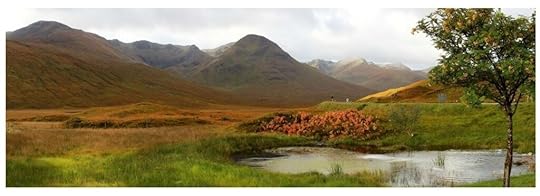
The weather during September and into October in Scotland can be surprisingly pleasant but also unpredictable. This can make your packing list for Scotland In Autumn a bit tricky.
I’d recommend the same items that I have suggested for springtime – light layers – but also add a warmer and more insulated padded raincoat with a hood. Team the coast with gloves and a moisture wicking scarf to keep out any chilly draughts.
Pay attention to what footwear you are wearing at this time of year too. No one likes cold wet feet and so waterproof trainers or boots and warm socks are recommended.
WHAT TO PACK FOR SCOTLAND IN WINTER(December: January: February)

Visiting Scotland in winter is to experience various degrees of cold weather with very few hours of daylight. During December and January, due to Scotland’s latitude, there are only four or five hours of daylight at best depending on the levels of cloud cover and the further north you go then the less daylight you’ll have – if any – at all.
Yet, winter in Scotland can be magical. Outside there are snowy landscapes, winter sports, brisk walks. Inside, warm fires, friendly people, hearty food… and a dram of whisky!
Then there are the Hogmanay celebrations that bring people to Scotland in wintertime from all over the world. Especially for the famous Princes Street Hogmanay Party in Edinburgh. But what to wear? What should be on your Scotland In Winter packing list?
Bring warm layers and also thermal underwear. Cosy, woollen, fleecy thicker top clothes to keep you warm. You’ll need a longer length warm and waterproof coat. A wool scarf – I like a blanket scarf – and of course gloves and a warm hat.
Footwear should be sturdy with warm linings. Boots are a good idea. Wear your footwear with warm soft wool socks. Footwear that isn’t sturdy or warm should be reserved for indoors only but avoid too-high-heels in case you are suddenly whisked to your feet for a quick reel of ‘Dashing White Sargent’ or ‘Gay Gordons’ at an impromptu Ceilidh Scottish dance!
So that’s my list of recommendations for what to pack and what to wear in Scotland.I’m sure it will be helpful to you.
Do have a wonderful time in Bonny Scotland and then Haste Ye Back!

 For Further Information and Resources:
For Further Information and Resources:Before you travel, please check the latest Scottish Government guidance
Follow Historic Environment Scotland
Visit Visit Scotland
Go to Scotland.org
Also The Scottish Tourism Alliance
Why buy travel insurance from World Nomads.com?Backed by specialist insurers and global assistance partnersBuy Online, even if you’ve already left homeBuy more cover and claim online while travellingCovers a range of adventure sports and activitiesGive a little back and support a community development projectAll of the information provided about travel insurance is a brief summary only. It does not include all terms, conditions, limitations, exclusions and termination provisions of the travel insurance plans described. Coverage may not be available for residents of all countries, states or provinces. Please carefully read your policy wording for a full description of coverage.
The post Packing List For Scotland appeared first on The Backpacking Housewife.



